Day 17: Sunday, 4 November 2018, afternoon.
Frazione Scagnano, Comune di Caramanico Terme, Pescara, Abruzzo. The search for house #31 on Via Something continues.
Sometimes serendipity pays off in the most amazing ways.
In the course of preparing for our trip, in September of 2018, I sent an email to a Carapellucci in the U.S. who is from a different family than mine (though his grandparents were from another Abruzzese town not far from Caramanico), with whom I compared genealogy notes 10 years ago. His name is Dan, and he’s a gregarious sort, so in the throes of frustration over Italians not replying to my emails, one night I thought, “I’ll write to Dan, because he’ll reply.” I sent him a cheeky “Heh, we’re going to Caramanico in a few weeks, need photos of anything?” figuring we’d have a nice chuckle.
It bounced back: dead email address, but I don’t give up easily, so I guessed at a few “generic” possibilities, e.g. [email protected] and other similars, and sent it again. A David Carapellucci in Canada forwarded it to his mother, Vilma Carapellucci, who replied. She is actually Vilma Ricci married to Gino Carapellucci, and guess what? Vilma and Gino are both Italian-born, from Caramanico, migrated to Canada in the 1970s, Vilma speaks Italian and works at the Italian Consulate of their Canadian city. I hit the jackpot!
Though we couldn’t figure out how we (the Carapellucci of Schenectady, New York) were related to her husband Gino, Vilma looked at our 100-year old birth and marriage documents and gave us some information on churches, locations, etc., and set us up with some people to help us in her hometown while we were there.
First day back in the U.S. from our trip, I heard from Vilma.
On Nov 6, 2018, at 5:16 PM, Vilma Carapellucci <xxx> wrote:
Hello Janice
How was your visit to Caramanico?
Haven’t heard and was wondering what you were able to discover.
Vilma
My reply:
Dear Vilma:
The trip was great. Caramanico Terme was lovelier than we ever anticipated. We expected a poor, rundown place that was trying to hang on with an invented “spa” industry.
Wrong.
It was like a Rocky Mountains ski town, my sister Loraine said. Meaning: there’s a main event (skiing in the Rockies, spa treatments in Caramanico Terme) plus, for affluent people who need something to do between their main events, there are ancillary services (restaurants, brew pubs, pastry shops) and upscale shopping (clothes, housewares, collectibles). And I thought Americans were the only people who eat and shop as recreation.
We found all the churches we sought, but we had a hard time searching out the home addresses that are on our various vital records: Via San Tommaso 31, Via Fonte Santa Croce 31 and Via Scagnano 31.
And wow, people were so friendly and helpful, even those who had no information to be helpful with—but wanted to talk at us in Italian for an hour or two anyway.
First, we had advice from Davide Cristofaro who owns the Hotel Arimannia where we stayed. (Beautiful place, by the way, recommended to all.) It was useful, but he dismissed the notions of visiting Scagnano and San Tommaso, because, you know, frazione, peasant villages with none of the appeal of the thriving metropolis of Caramanico (population 2,000).
Sorry bro’, that’s where our people are from; we’re going there.

We drove around the two frazione and tried to figure out which houses were old and how the numbering system works. It was obvious that the stone, unearthquake-proofed buildings are the old ones and that most, being unsafe to live in, have been abandoned or are used as garages by people who have built newer houses nearby on their own land. None of the old buildings still had numbers on them. Sometimes they were between, or slightly behind, the newer houses, so we tried to guess: Is that number 31, if the new house in front of it is 29?
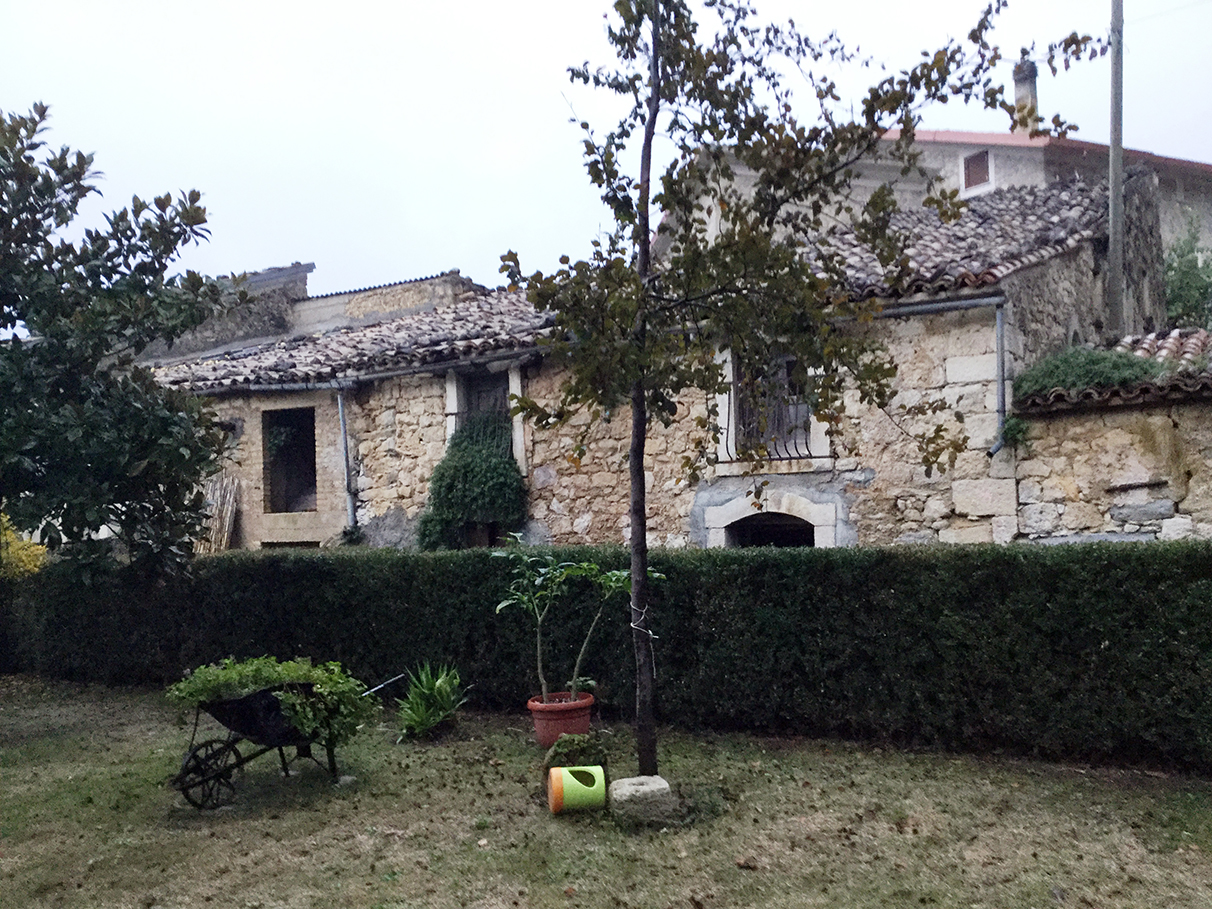
But the numbers aren’t consecutive on the streets, nor do they follow the American system of odd numbers on one side of the street, evens on the other side. The numbers don’t even go in the same direction on both sides of the street. Whew.
In Scagnano, there was a woman outside her house, so we introduced ourselves and she, Diana, knocked on the door of an elderly neighbor: “Do you know anything to help these people? They are Carapellucci and Marinucci (our great-grandmother’s maiden name).” Nothing. Then we visited another neighbor who told Diana, “Davide called me yesterday,” and she had nothing. (She was too young.)
Then Diana thought, “They need to talk to Angelina and Gino.” She got in her car and commanded we follow her to their houses, where Angelina invited us in for cookies. (Pizelle! Oh my God, we love those cookies!!!)
Angelina yells upstairs to wake her cousin Gino (who, we figured out later, lives in an adjoining house), who starts puzzling over our documents and talking/arguing with Angelina about this and that. They were both Marinucci, but Angelina’s maiden name is Carapellucci, so the plot had thickened.
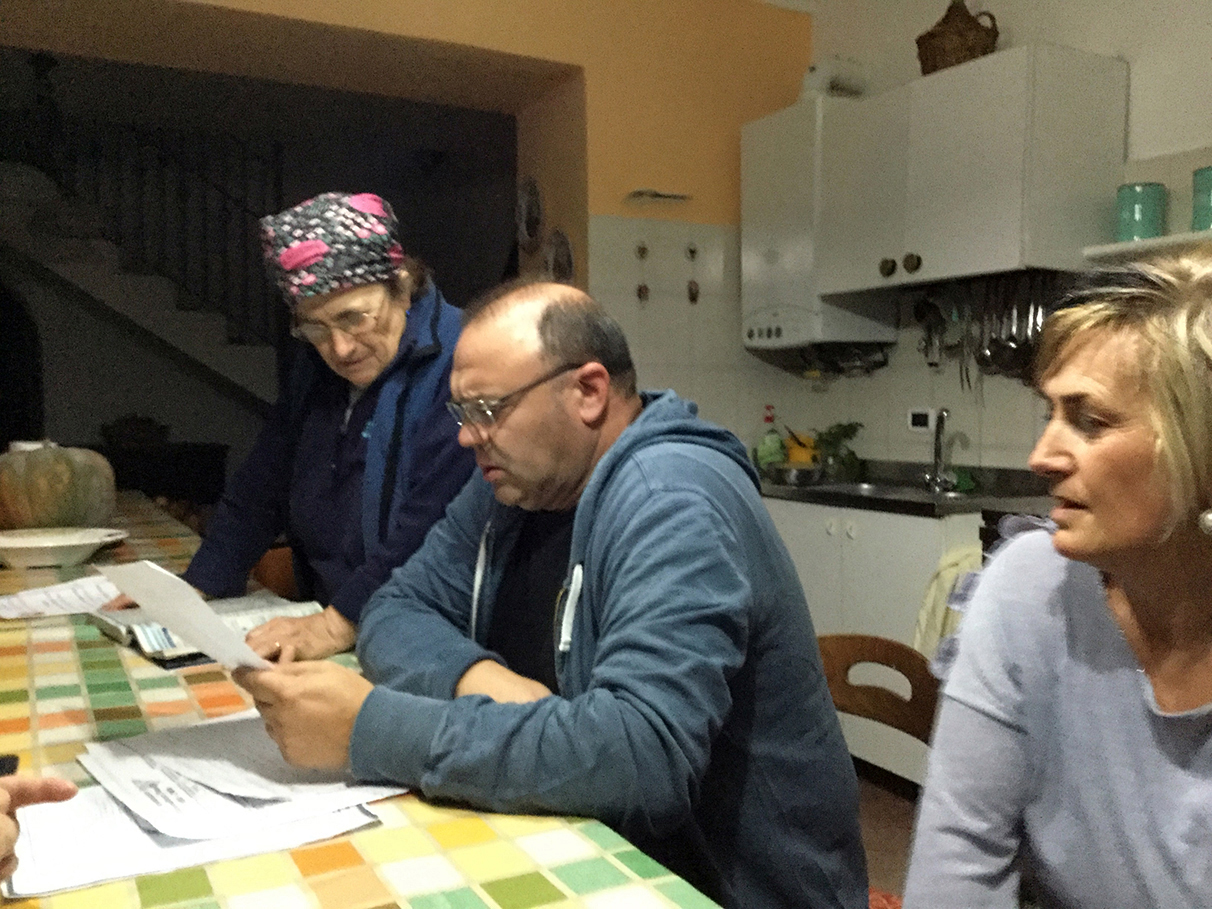
We piece together that our Carapellucci people started in Caramanico, but our great-grandfather, Antonio Carapellucci, moved to Scagnano, presumably when he married Anna Marinucci in 1877—maybe to acquire land from her family? (We think they must have had something to sell in Caramanico and/or Scagnano before they left in 1907, as they bought a farm in the U.S. only a few years later. Where did they get the money?)
After about a half hour of the two of them puzzling over the documents (Diana left in the meantime), my sister Loraine whispers to me “I think these are Vilma’s people.”
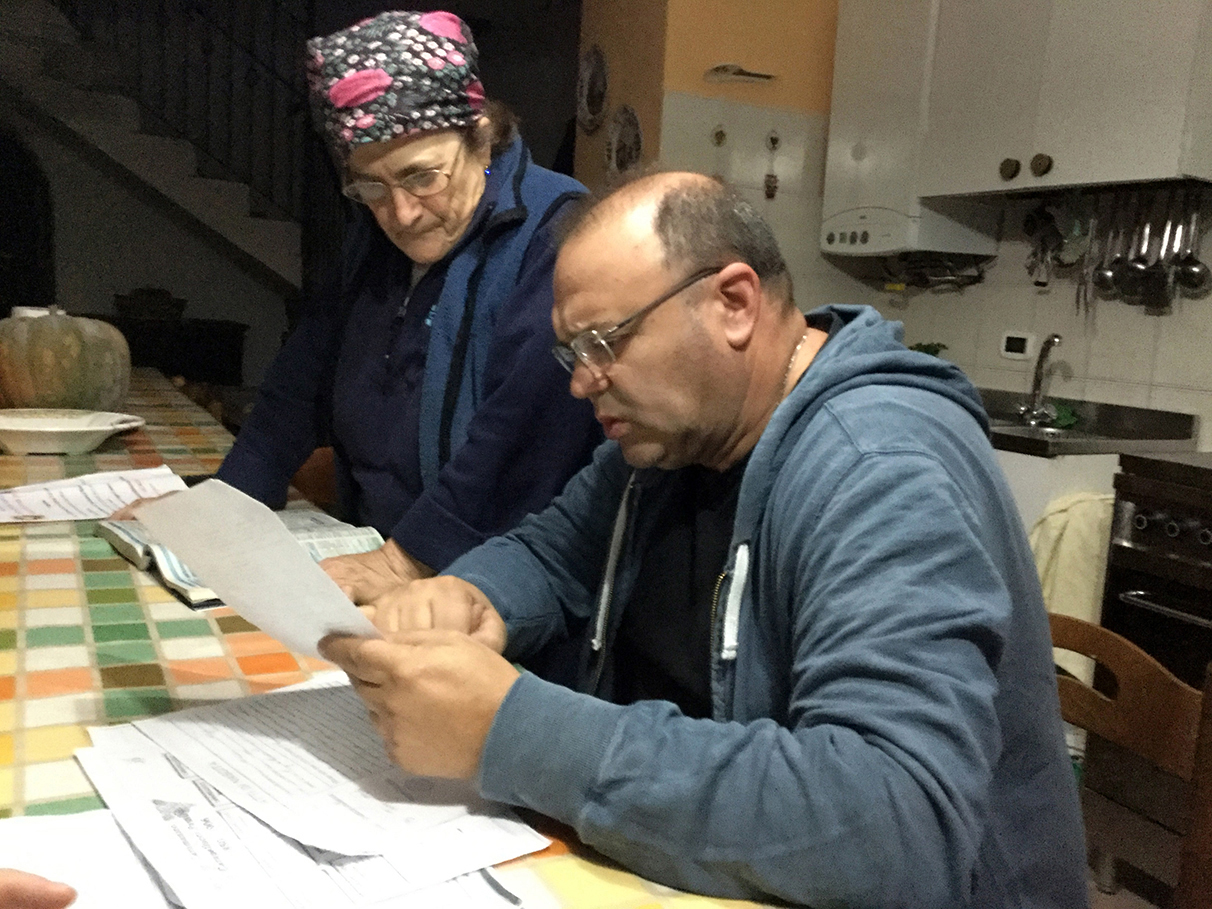
So now we’re looking at each other (3 of us: me, Loraine, Loraine’s husband) like “How the hell do we get out of this woman’s kitchen so we can go eat dinner?” (We were hungry.)
Then we asked Gino something about “Via Scagnano” and he comes out with “All the streets in a frazione have the same name—the name of the frazione.”
Huh? So all the streets, even if there are 4 or 5 of them, are named “Via Scagnano?”
“Yes.”
That’s it. We’re wasting our time. The address of the restaurant we found on Google Earth years ago, which we were counting on using as our reference point (Tana del Lupo; Contrada Scagnano 19), is irrelevant, and we’ll never know which house on which street was number 31 in 1907. Let’s go.
Then Gino says, “And they re-number the houses periodically.”
Us: “How often?”
Gino: “Every ten years or so.”
Oh my God this is really pointless!
But by then they had called Elvira Carapellucci, 80-something woman with dementia, and insisted we visit her to see what she knows.
Back into the cars, Angelina rides with us and directs us to Elvira’s house.
Elvira’s attendants ask her questions and she has nothing for us, so we make our exit graciously, drive Angelina back to her house, resist her entreaties to come back tomorrow for spaghetti (she had given us a demo of pasta making earlier when we were in her kitchen), and make our retreat.
I’m not complaining, Vilma. It was fun. Your relatives were all soooooo nice. They really, really wanted to be able to help.
And it was such a pleasure to listen to people who knew how to pronounce “Carapellucci” and “Marinucci” smoothly and without pausing, because we’ve lived our whole lives (in the U.S.) hearing stumbled syllables followed by “Is that an Eyetalian name?” (To which I now reply, by the way, “It is, but it has also been an American name since my grandfather naturalized in 1918, and it’s time for you to learn how to pronounce it.”)
And Gino did answer our questions, finally, even if it inadvertently!
We also thoroughly enjoyed the drives through the mountains approaching and leaving Caramanico (we entered on the roads from the south and left via the north), and we understood our American ancestors much better after seeing how much that part of Abruzzo looks like the Adirondack mountains in New York State where they settled: deciduous trees with autumn-colored leaves! I’ve never seen that elsewhere in Italy.
Even standing in Elvira’s driveway: out in the “country” away from the lights of the big city of Caramanico, we enjoyed looking at the stars in the totally black sky, which is something we never see on the east coast of the U.S. (because it is so populated).
The landscape of Abruzzo is unique and especially beautiful. I can understand why you, or anyone who is from there, would feel possessively proud of it. You have very good reasons. We’re thinking we might even return one day to hike in those glorious mountains.
Thanks for ALL your help, it was major.
Send me pics of your next trip. Now that we will recognize places, it would be really fun for us to look at someone else’s vacation photos from there!
Janice
Loraine adds: Janice left out the most important part. Angelina and Gino recognized the names of the Marinucci witnesses on our ancestors’ birth certificates. Angelina and Gino are related to us on the Marinucci side, we just don’t know how yet, and we will keep working to figure it out. Your family is wonderful, just wonderful.
-Loraine
Janice adds:
Ps to Dan: if you ever see this post, send me an email from your new address, dammit—I’ve got photos to show you!
——————————–
Epilogue: The next day, Loraine, who had clearly been cogitating on this all night, figured out that “our” #31 house is one of the old “garages” in front of Gino and Angelina’s houses. Our Marinucci—Anna—left so long ago (1907) that no one remembers her anymore, but Loraine thinks that because she was a contemporary of those witnesses, from whom Gino and Angelina are probably descended, probably all three families lived in those shacks at the end of the driveway next to the two new houses where Gino and Angelina live now (not in photo.) Anna Marinucci and her husband—“our” Carapellucci (Antonio)—sold their shack to one of the other two Marinucci families and left town. Luckily, I had snapped a photo of the “garages” when we pulled in, just before the sun went down. Here it is—the three low roofs, only. (The tall building on the far left is a real house, inhabited by someone we didn’t meet.)
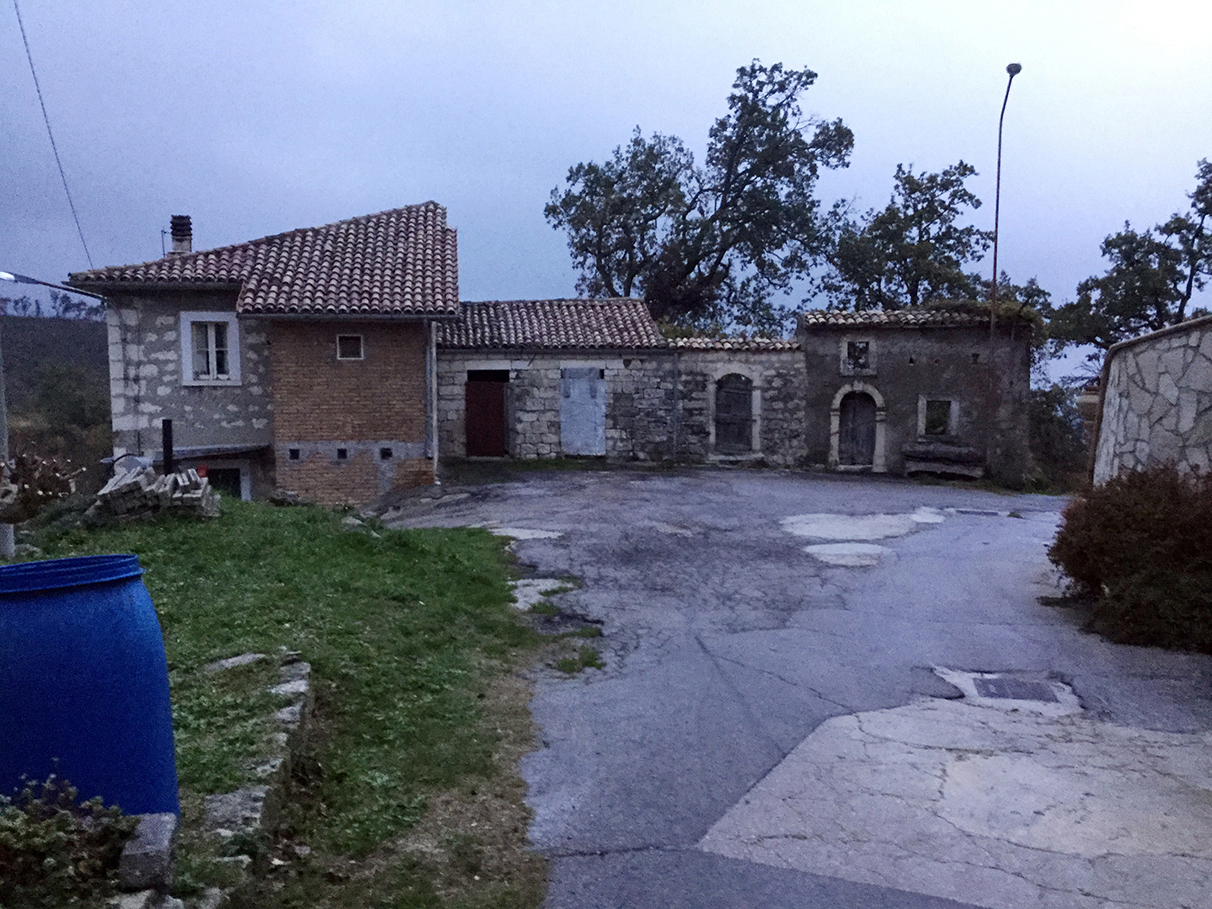
And there’s always Google Earth which has better lighting.

So that’s it, and we are owning it: Our grandfather, Emilio Carapellucci, was born in, and grew up in, one of these three shacks in Scagnano, Frazione of Comune of Caramanico (now Caramanico Terme). We found our roots, people!
Day 17: Sunday, 4 November 2018, morning.
Caramanico Terme, Pescara, Abruzzo. The search for house #31 on Via Something.
Wow, what a pleasant day. We left our hotel to discover a parade forming on the road below: Veteran’s Day. Brass band, veterans identified by Tyrolean-looking felt caps, and, yes, we were welcome to join the parade which was about to walk through town. Why not? (Brother-in-law Dave, who has not one drop of Italian blood in him, plays trombone, so when we see brass instruments, we throw him a bone.)


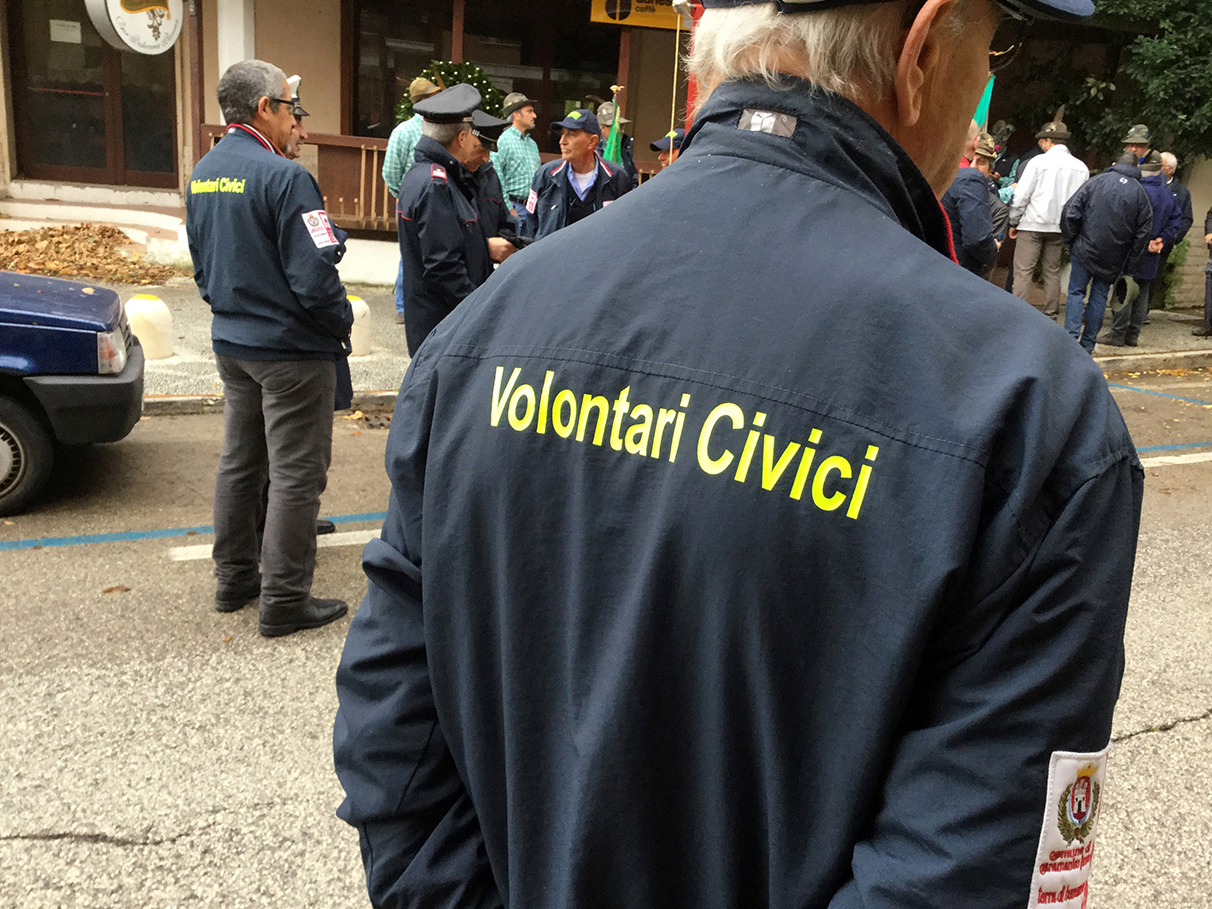
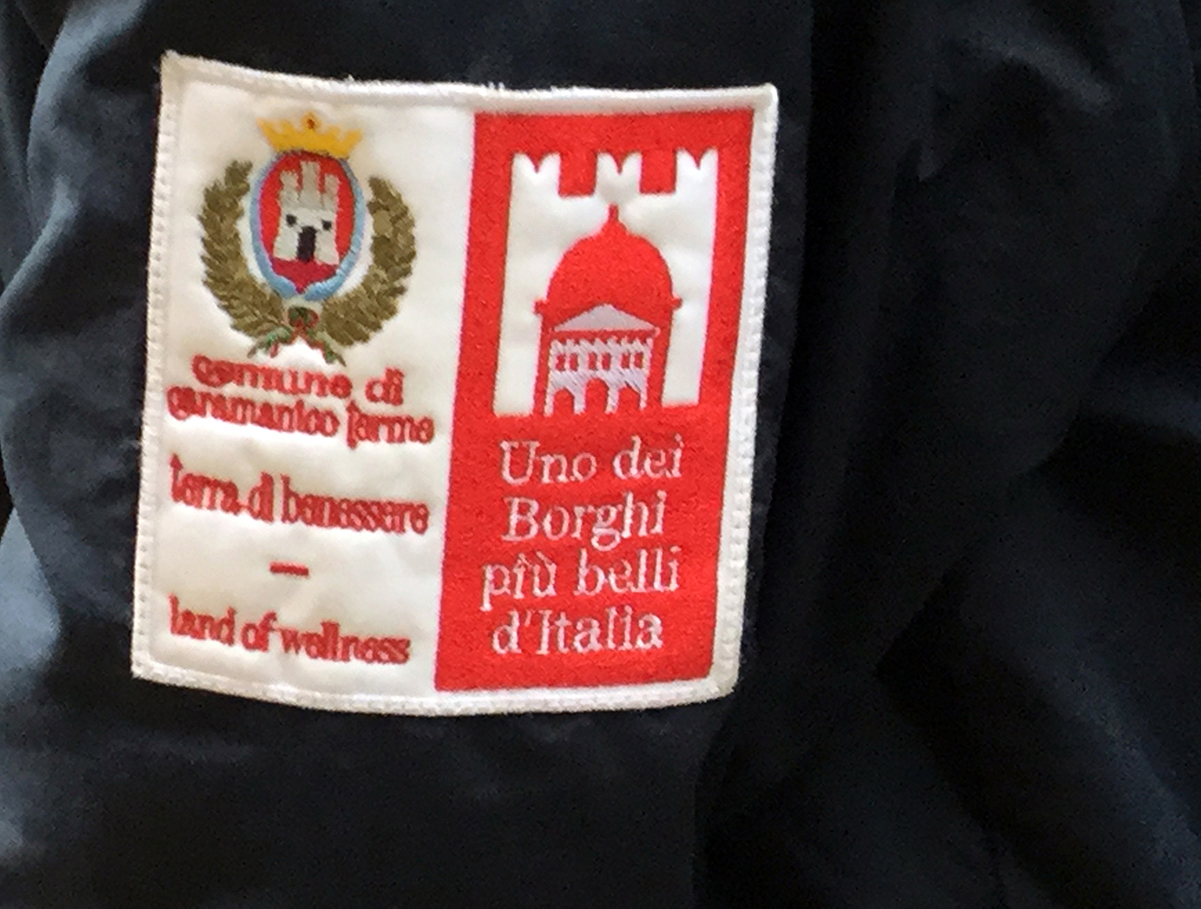
Most of the veterans looked too young for WWII, but we did hear a chilling WWII story about Caramanico locals harboring a downed British pilot in a barn and being lined up in the street and shot when the occupying Nazis discovered him.
My sister and I looked at each other and whispered: So if our ancestors hadn’t moved to the U.S., where they ended up fighting in (and surviving) both WWI and WWII in the U.S. Army, would they have gotten embroiled in this Nazi incident instead?
Here’s a movie of the parade in caramanico.
We followed the procession to one of the town’s churches, then peeled off and walked on our own.
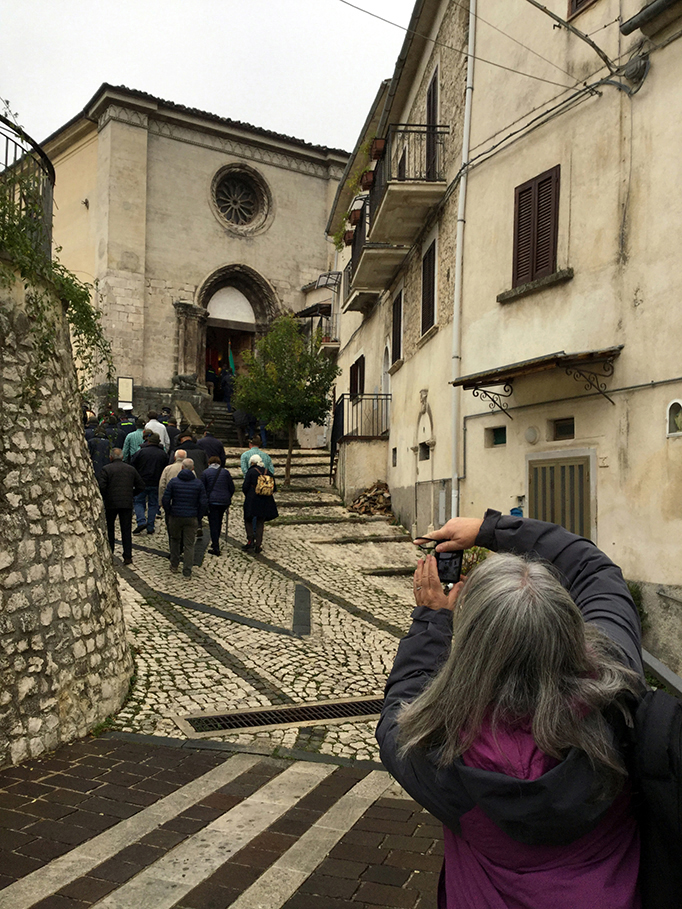
We investigated the war memorial, the town hall, and the historic church with a roof that caved in during a big snow storm a few years back but, happily, is already being repaired. See photos.
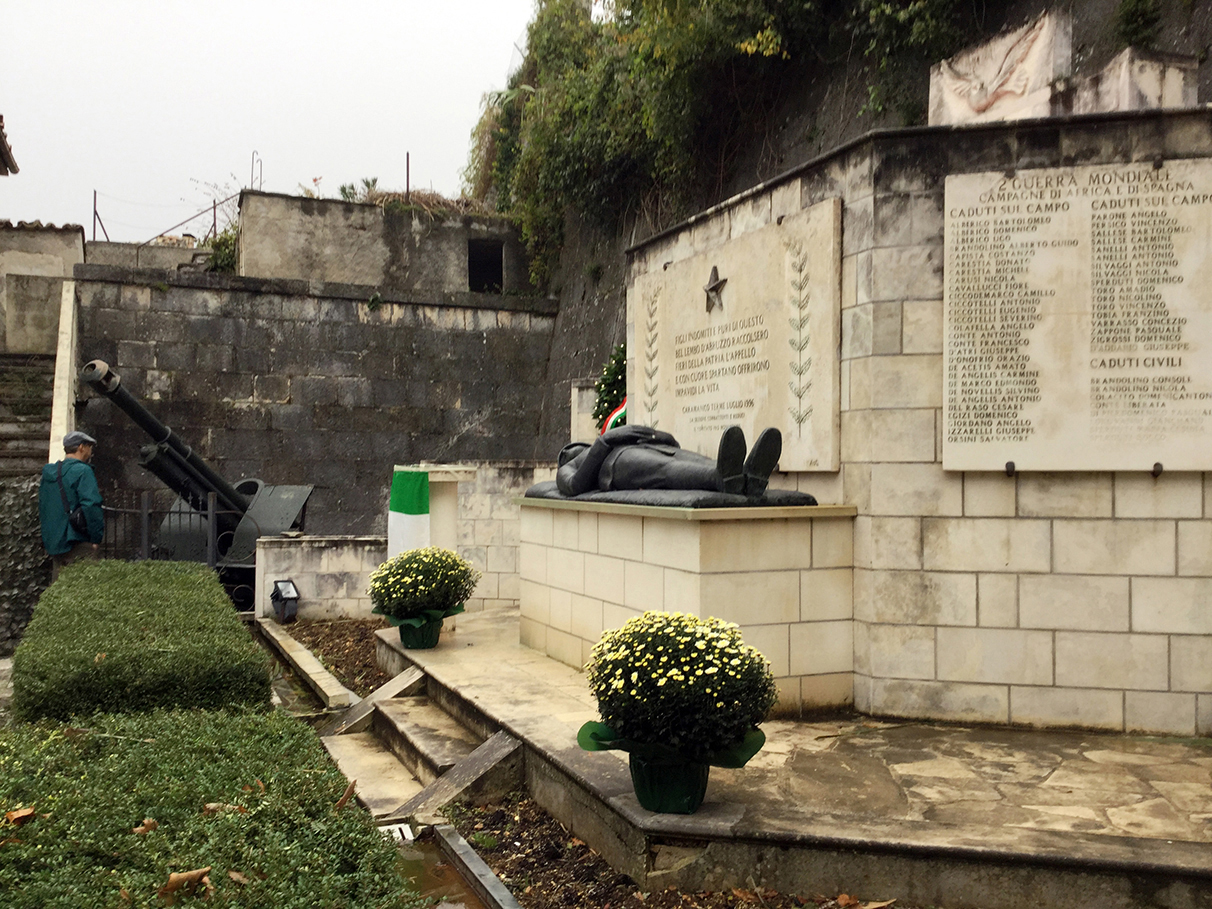
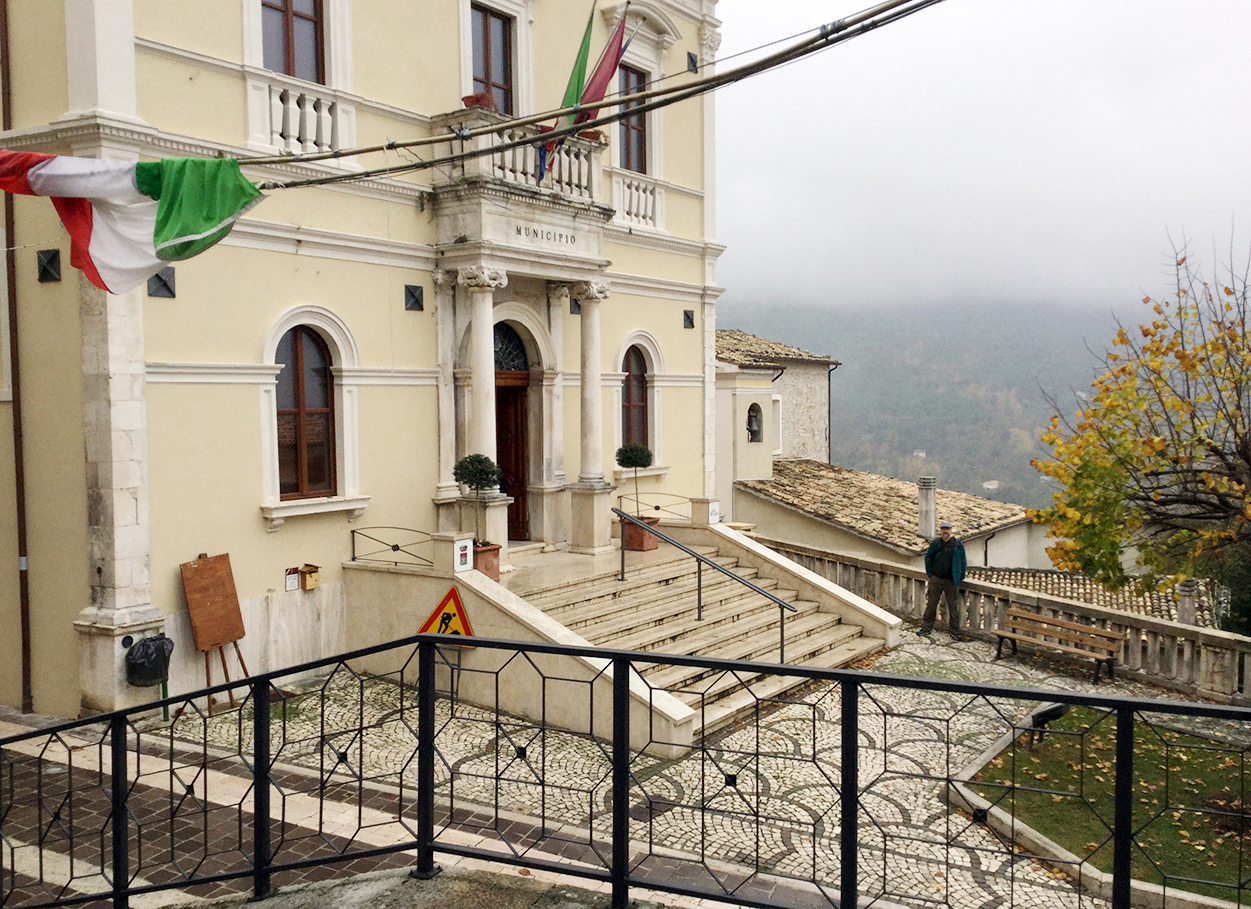
Then we grabbed the car and headed for some outlying places on our list.
First was a pedestrian-only road at the far east end of Caramanico Terme called Via Santa Croce Fonte. We had found it on Google maps and thought it might be the location of our family’s ancestral home, house number 31.
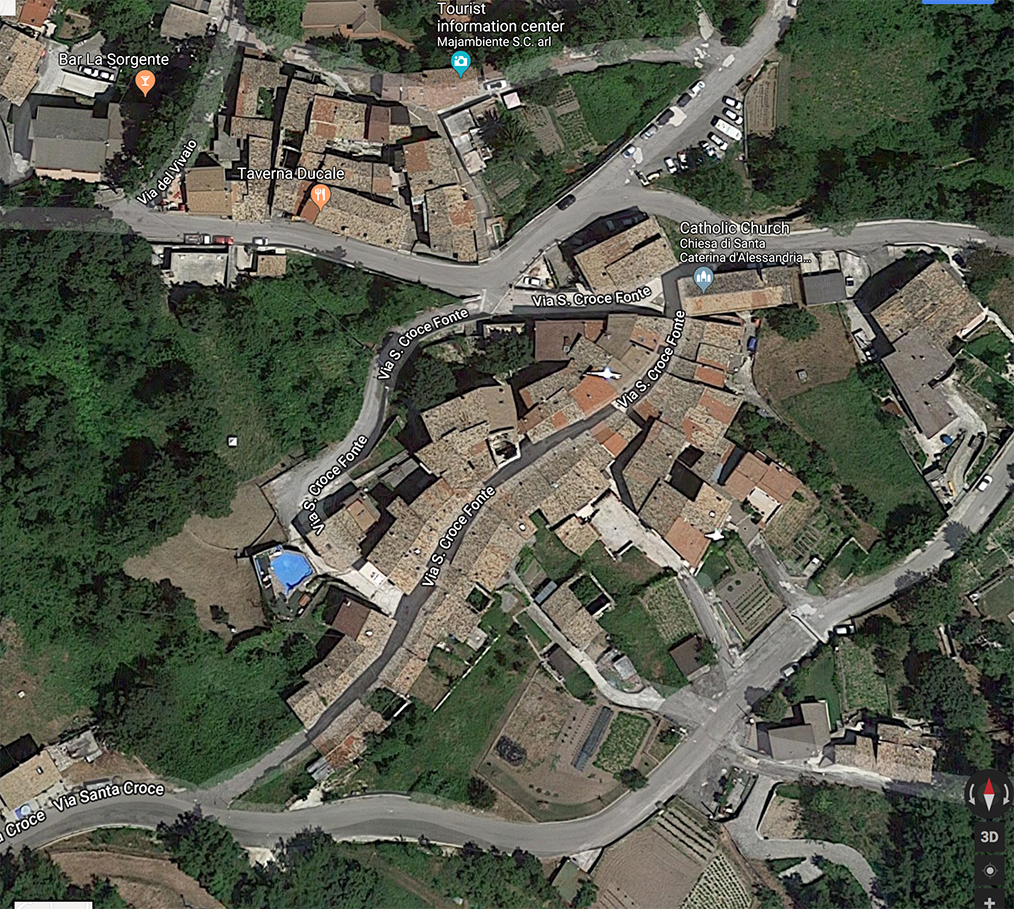
It was quickly revealed why it’s pedestrian only: super steep, lots of stairs. We hiked up and down looking for number 31 and couldn’t find it. But there was a number 29, so we decided the one next door was 31 and snapped a lot of photos.
By this time, we had attracted the attention of the inhabitants of 29 who stood in their door chatting with us, then invited us in for drinks, etc. No thank you, no thank you. I was tempted by the two 8/10-year old girls who were so innocent in their curiosity that they stared at us non-stop the whole time we chatted with their parents. They had visitors who spoke English and broken Italian, and that alone was enough to make us fascinating, apparently.
We spent a few minutes in the small chapel next to 29, so that we would have “experienced it,” in case we discovered later it was our family’s church.
Then we left and drove north to the frazione of Scagnano.

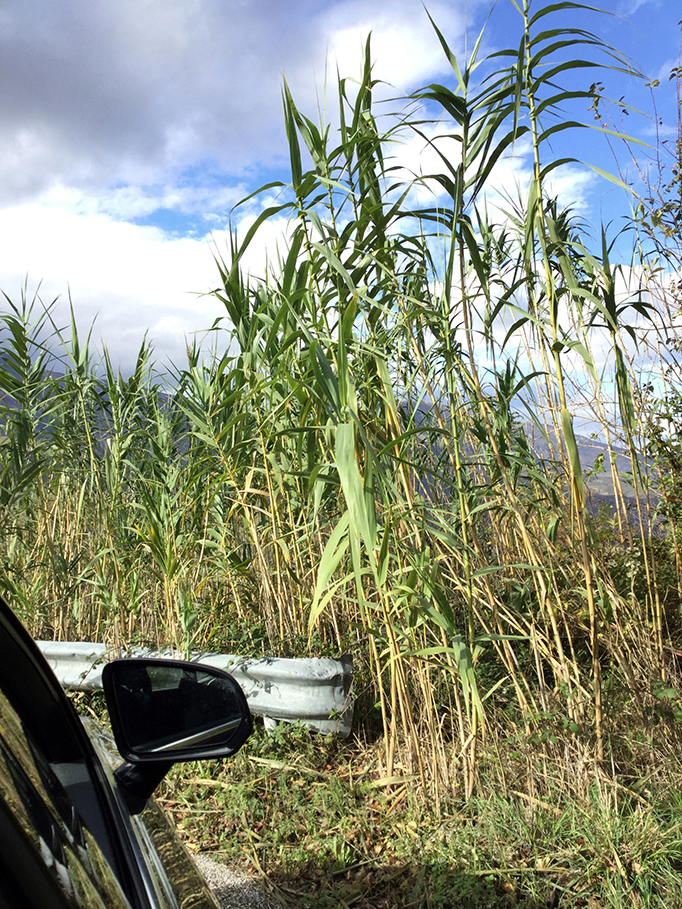
]]>
Day 16: Saturday, 3 November 2018.
Travel from Solofra, Avellino, Campania, to Caramanico Terme, Pescara, Abruzzo.
We got up early (for Carapelluccis), said goodbye to our wonderful hosts, snapped a few photos of them and their lovely property, also the view of Solofra from their hill (finally with no rain and decent light), then hit the road for our longest driving day, from one grandfather’s hometown to the other’s: Solofra, in Avellino, to Caramanico Terme, in Abruzzo—about 200 miles.

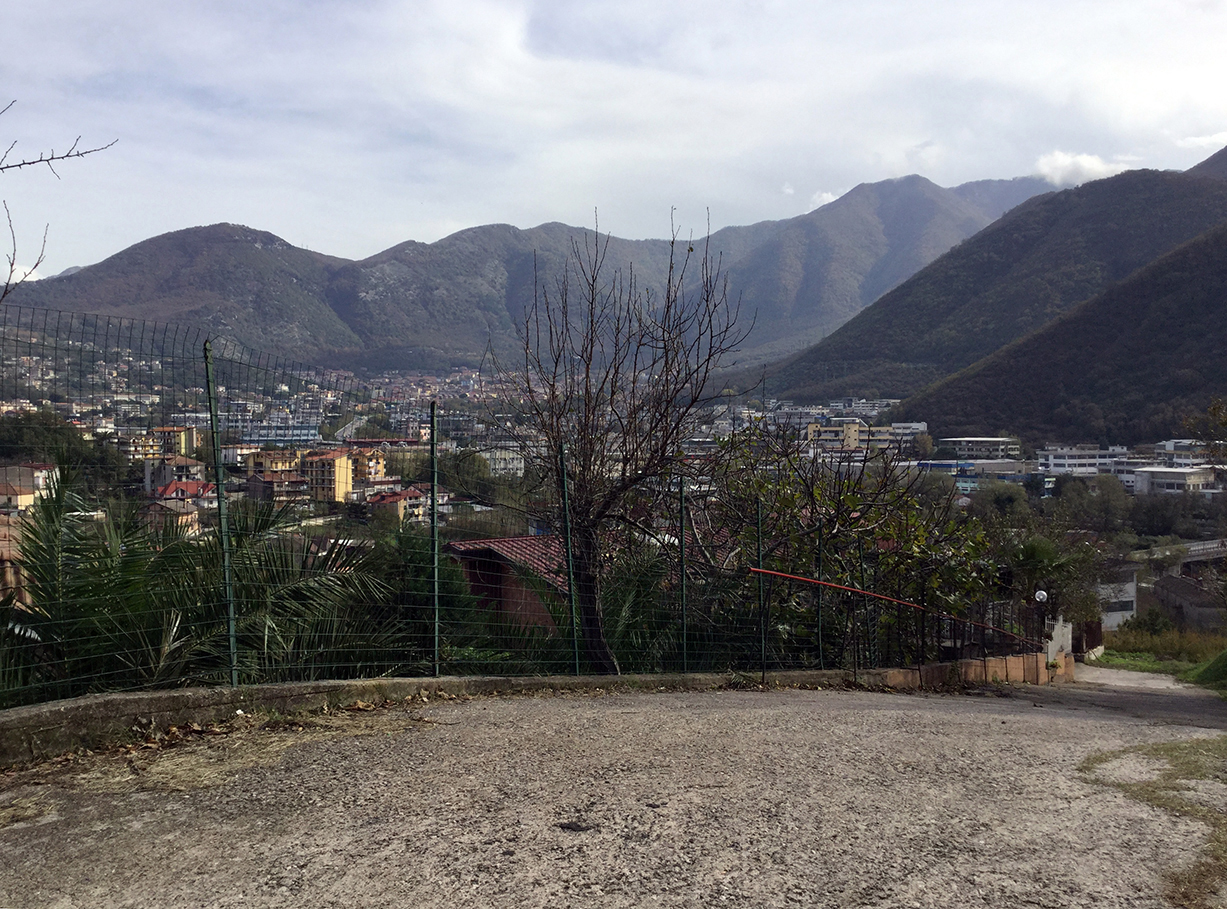
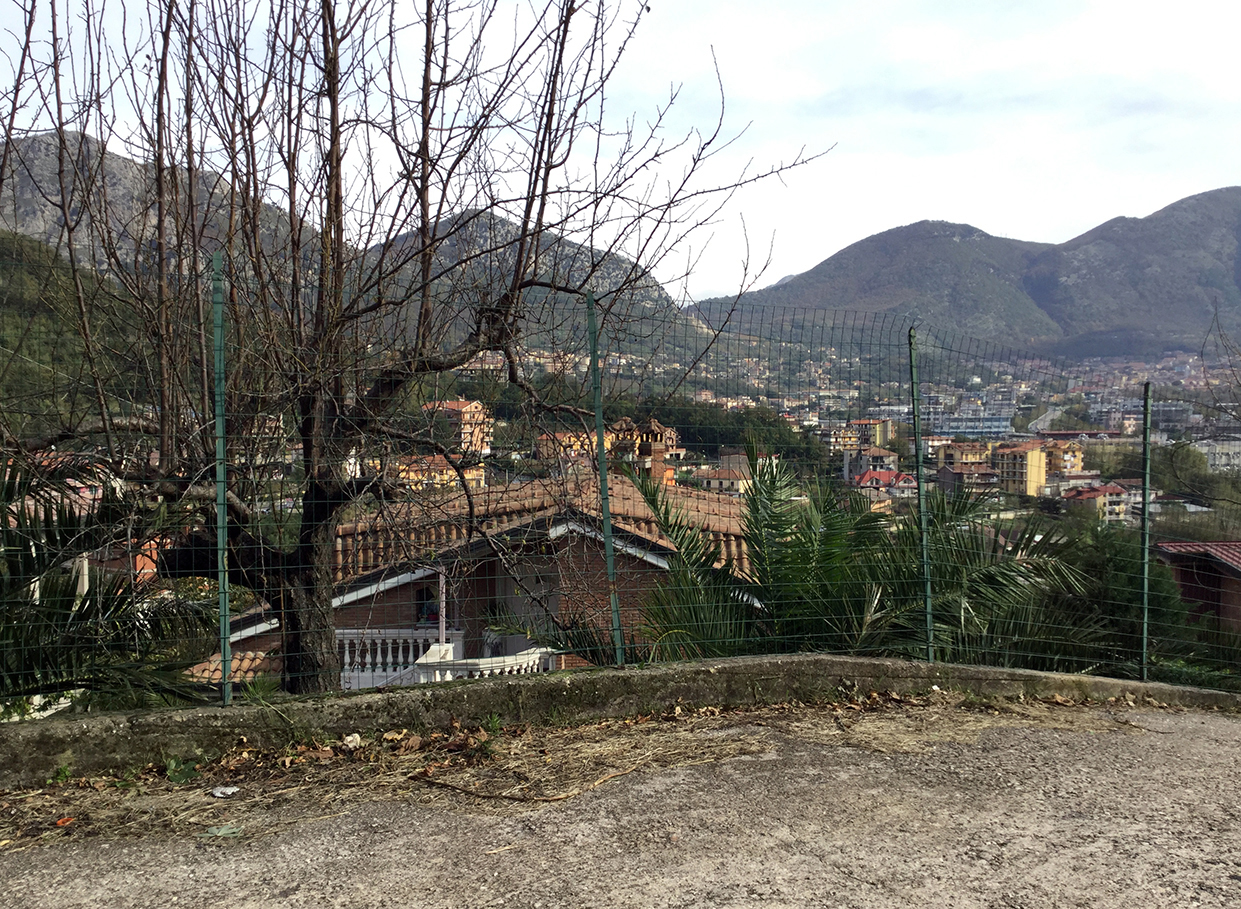
We had a nice day riding through the countryside of Campania, Benevento, a tiny bit of Molise, and Abruzzo.
Major shout-out of thanks to my fabulous brother-in-law Dave who did all the driving and my fabulous sister Loraine, who navigated using Google Earth on her phone. I got to sit in the back and just look out the window all day, like a princess with no responsibilities. (Princess Marg, for family members who know what that means.)
I made one contribution: a one-hour stop in the ancient ruins of the Roman city of Saepinum (Sepino), just outside Altilia. Read about it here.
A city on a former main road which Samnites, and later Romans, used to move their animals north and south seasonally, this place is totally off the beaten tourist path, and you can have it all to yourself. Park in the nearby restaurant and walk around, free admission.
It’s probably not a place worth searching out, unless you have a serious obsession with ancient cities. Not me! I’ve been spared at least one obsession, thank you, but if you ever find yourself on the north side of the mountains near Naples, do check it out for the rare experience of wandering a Roman site at will and not having other tourists mess up your photos.
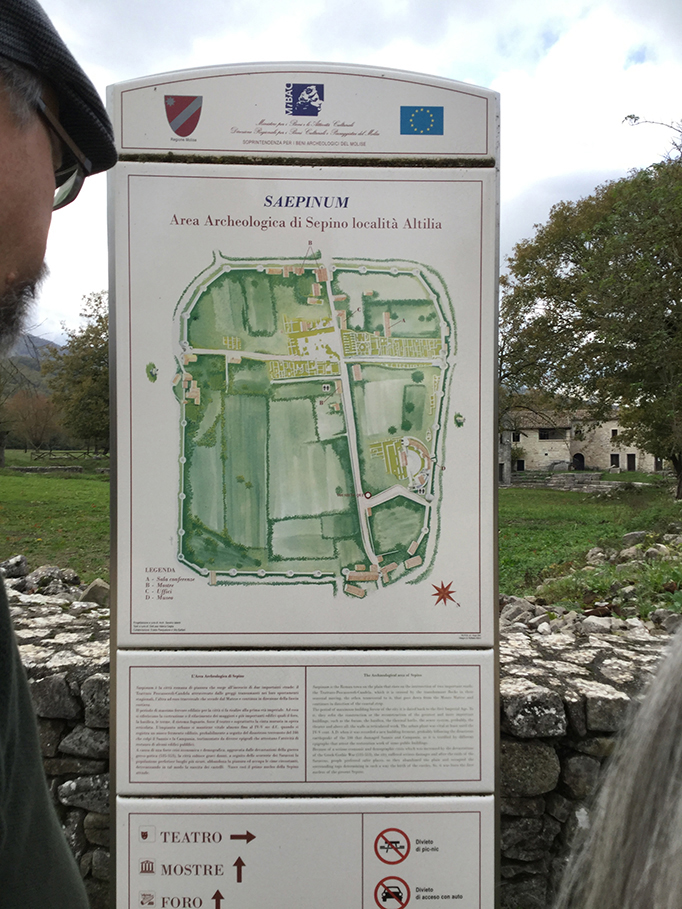

Click here to watch a contemporary performer on this ancient stage: Saep3
Being a graphic designer, I’m always a sucker for well-made Roman lettering. Pop quiz for anyone who’s been reading my posts from the beginning of the trip. What is the name of this font—it’s name now, having been known as “carved letters” at its inception, long before anyone knew anything about “fonts”?


Check out this “adaptive reuse” of a Roman plaque as the cornerstone of a medieval barn.
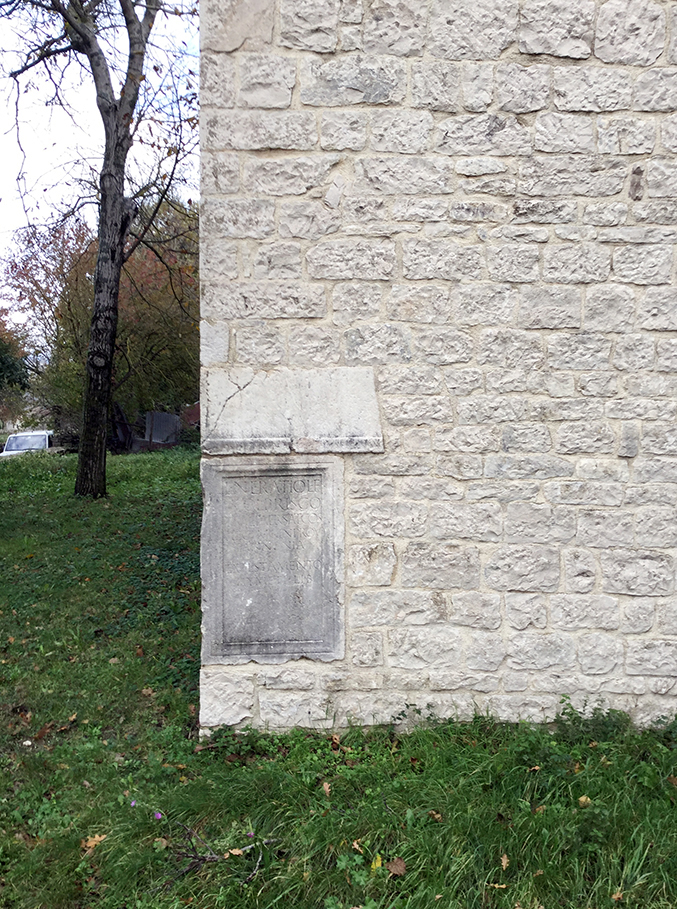

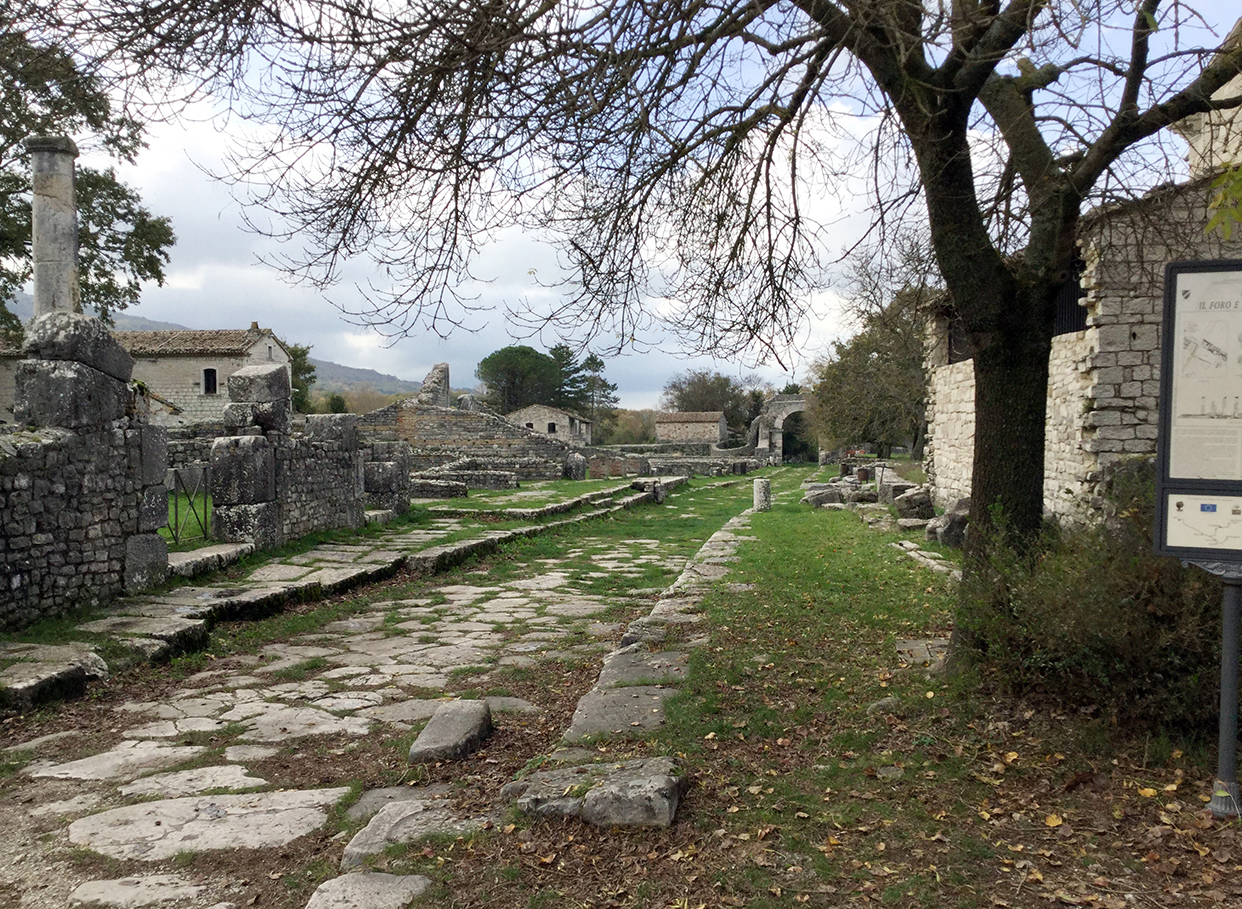
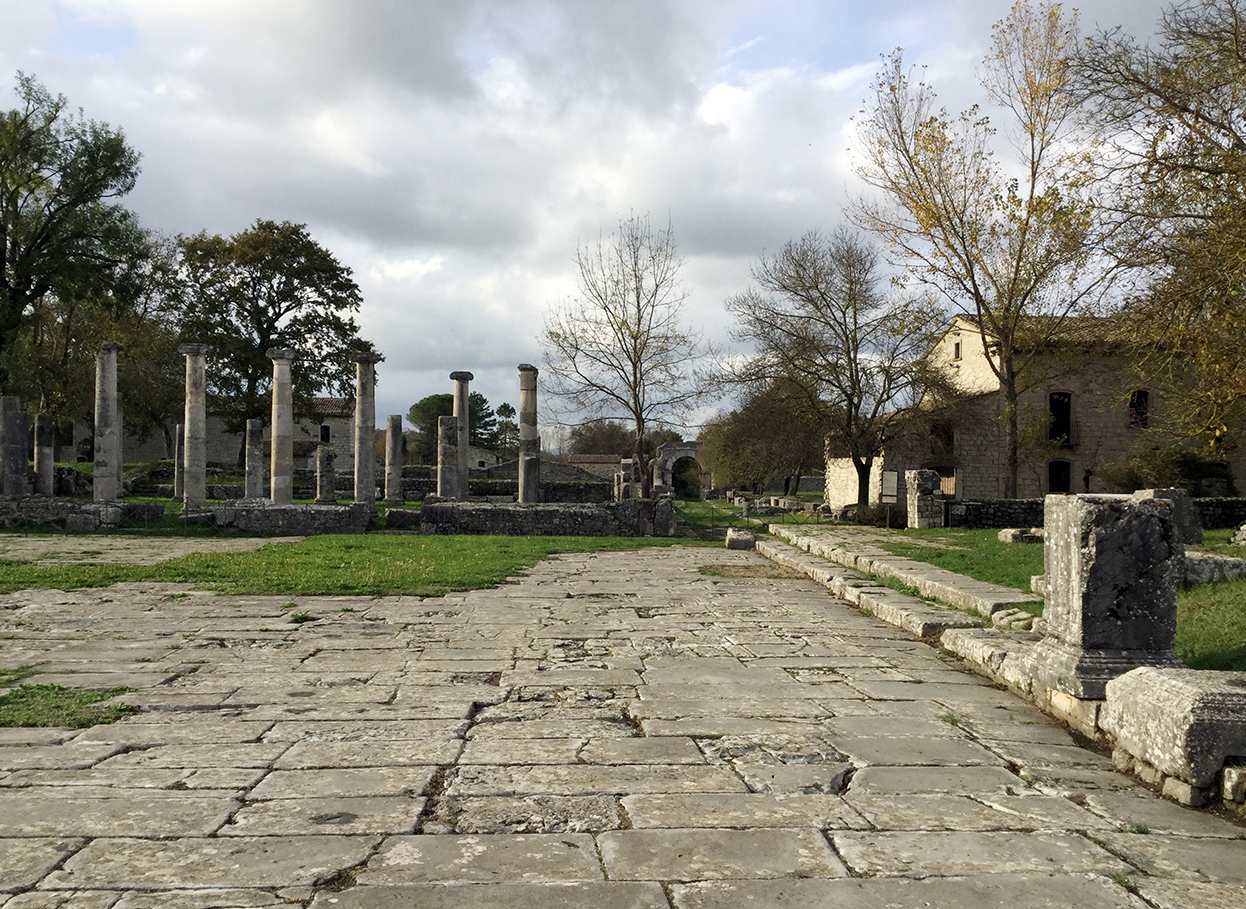
Back on the road, we see a lot of towns in the hills to both sides of the road. I expected back-county Italy to be poor and rundown. I’m pleased to report: not so. Though I only saw the towns from a moving car or at occasional rest stops on a highway, mind, I can report that there was farmed land everywhere (which was, presumably, thriving), every town had at least one or two factories (near the highway, plus maybe more elsewhere), and nowhere did the land or buildings look deserted, “untidy,” or rundown.
Plus, we saw multiple electric wind (mill) farms on the tops of ridges. At one point, we drove by a factory with parts out in the yard that I thought looked like airplane wings. Huh? Then it hit me: they were wind mill blades! So the mills were being made, and I guess assembled, mere miles from their sites!
I read later online that some people oppose the windmill installations for ruining their views of mountain ridges, but to us this is relative. In the U.S. we desecrate mountain tops with far more egregious strip-mining. I thought the windmills looked kind of cool.
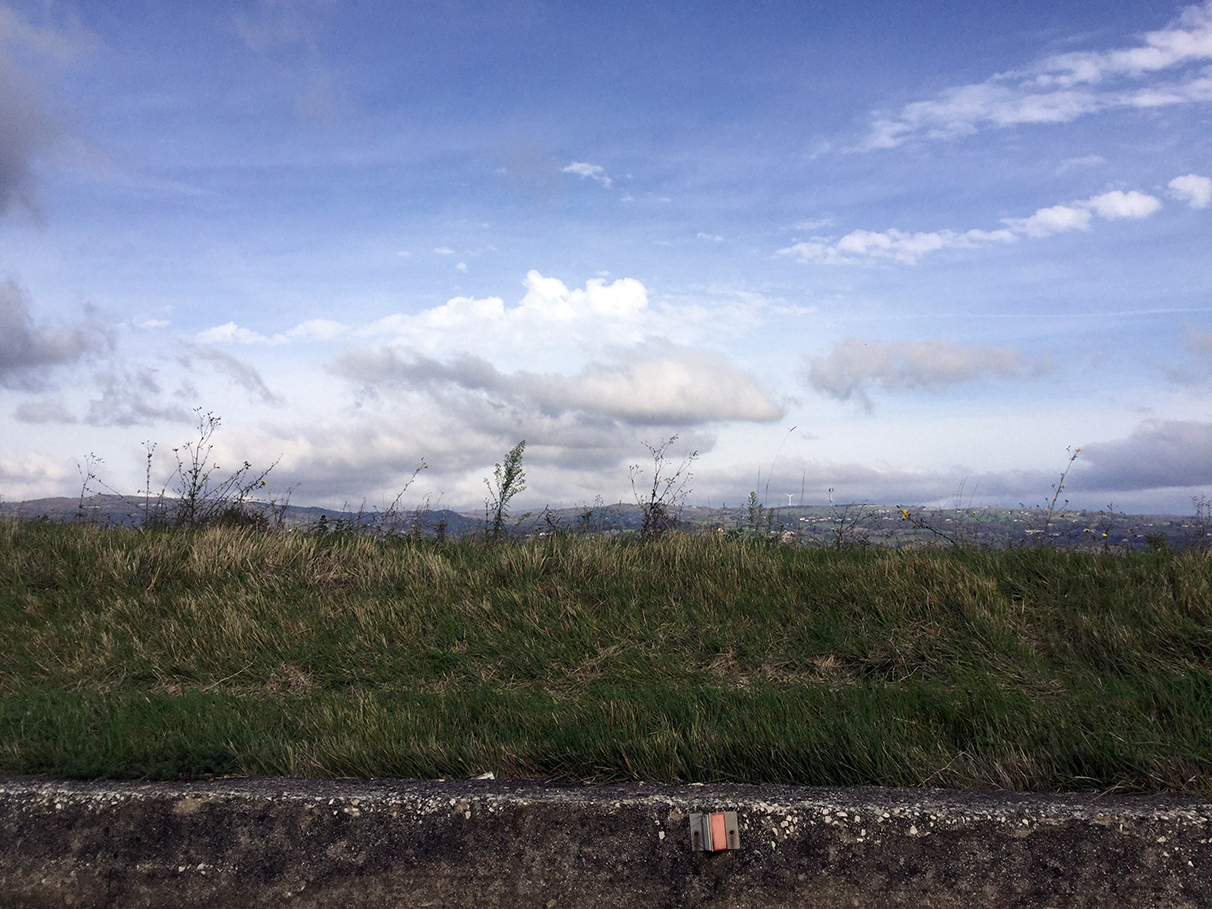
Also, the roads were well maintained, including in areas with serious winter weather, and there were numerous tunnels through mountains and bridges over high chasms.
Our drives were a lot faster than our ancestors’ trips in horse-drawn wagons when they left these towns in 1907, that’s for sure.
]]>
Day 15: Friday, 2 November 2018, morning.
Solofra, Avellino: All Souls’ Day, Giorno dei Morti (Day of the Dead)
Unexpectedly, we got another shot at meeting with Lucia Petrone, and my sister Loraine Carapellucci and I jumped on it. Without the translator this time, Loraine wielded Google Translate on her phone and Lucia used Google Translate on her computer. Between the two machines and my tiny bit of Italian vocabulary, somehow we communicated with each other.
First, Lucia showed us two books on the town’s history. Were they available to buy? No. No more in print, no extras in the office to sell.
So Loraine and I started photographing their pages, then Lucia interrupted us to tell us more information and to show us stuff on her computer. She would start to talk, then stop and type frantically on Google Translate instead. I loved the woman’s enthusiasm!
Loraine and I whipsawed between looking at Lucia’s computer, looking out the window at the church across the street, and photographing those unavailable books.
Lucia told us the story of the construction of the Collegiata di San Michele church, which astonished us.
The night before, we had learned from Alfonso Buongiorno how the tanning industry Solofra families started as conversos (former Jews) from Spain who migrated to Florence in the 1300s, which was the tanning center of Italy. At some point, they were invited by someone (a land baron) to move to Solofra to set up a competing industry.
Lucia explained that there had been an old church on the site of the Collegiata which the families deemed inadequate. In the early 1600s (which would be approximately 200 years after the converso families arrived in Solofra, so presumably the tanning business was profitable by then), they demolished the old church and built the Neapolitan Baroque building that exists today.
If we got the translating correct, Lucia told us the tanning families of the town pooled their money to build the church, and the chapels inside are named for them. They also hired the priest, who, besides directing spiritual life, functioned as the mayor (of sorts, this is before suffrage) and settled civil disputes. At one point, there was an argument over some matter and the priest defended the town instead of the government/crown. He was arrested, and the townspeople got him released.
“Collegiata”—collegiate—in the church’s name means it was also a school. There was a convent attached, and the nuns taught classes. Most astonishingly, girls attended as well as boys. Today, the school is, appropriately enough, the town’s public library.
And the church had one more role in town: bank. The founders of the church would deposit their money, and the church paid them interest. When they needed it, they could borrow it back, and then they would pay interest to the church.
This is an astonishing amount of power and autonomy centered in a non-governmental, non-royal institution. I’ve never heard of it anywhere in Italy, let alone in the south where the feudal system endured into the late 1800s. Has anyone else? Did we get the translating wrong?
When I told the story above to my friend Bill Russo in New York, I expressed it as, “They hired the priest, and he worked for them, not for the Vatican.” Bill blurted out, “That’s how a synagogue is organized!”
Is Solofra’s extraordinary history of progressiveness, self-reliance and agency a cultural legacy of its original families’ Jewish roots? Did the historic, formerly Jewish culture of this town create my ancestors’ can-do, optimistic personalities?
Looking out the window, Loraine remarked, “But what about the campanile (bell tower)? It looks different from the church.”

Lucia paused and placed her hand over her heart looking very pleased. Her reply: The campanile was built with the stones from the old church.
Loraine pointed out to me later that that question seemed to change the tenor of the whole afternoon. A switch flipped in Lucia’s head (and heart) regarding us: they get it. They care, and they are becoming involved in our history.
A few minutes later, when we were photographing the books again, Lucia came to the table, closed both books and pushed them across the table to us. “A gift. Please take.” We were speechless.
I hope she decided that those books were going to do more good for Solofra being on our desks in the U.S. than in a cabinet in her office, because Loraine and I aim to prove her right! We traded emails and plans to collaborate on future projects.
At one point, Mimma De Maio phoned in, so I finally got to talk to her in person and thank her for all of her work which I have been reading for years. She was my first “door” into the history of this town.
I suspect I am going to be involved with my grandfather’s family’s Italian hometown of Solofra, Avellino, for the rest of my life. And I am well pleased.
]]>Day 14: Thursday, 1 November 2018, afternoon.
Solofra, Avellino: Visit to Casa Buongiorno.
As promised, Alfonso Buongiorno arrived at our Agriturismo (with his brother-in-law, whom he enlisted to drive a second car) on Wednesday afternoon to take us (party of 6) to his home on a hill above Solofra. Alfonso, his brother, and his father Francesco own one of the tanning businesses in town, and they have new homes near each other in a “compound” that they built on the side of a hill above the old part of town.
When I walked in and saw 19th-century paintings on the walls, I knew I had found a soul mate. Alfonso said, “They aren’t expensive. I buy what I like.” I smiled and made a mental note for a future project: get Alfonso interested in hunting for Donatus Buongiorno paintings that are in Italy.
We met his wife Maria Giaquinto, who is an Izzo from Montoro Superiore, a nearby town. Remember New Yorker Bill Russo whose parents were both from Montoro Superiore? Bill’s mother was Anna Izzo. I felt the spirits starting to circle.
Bill actually found Alfonso for me. On Facebook, of all things. Much as I hate that site, I’m grateful it worked for this, because meeting Alfonso Buongiorno was a highlight of my trip to Italy.
Next we met Alfonso and Maria’s two teenaged children, Raffaella and Francesco, who couldn’t hide that they were a little annoyed that company arrived just as they were planning to go out with friends, and they were now expected to linger and be nice. (The ritual for the holiday, apparently, is that adults go to the cemetery and youngsters go to parties.) I didn’t catch all of the words, but I think the gist of the whispered conversation was “Daaaaaad….,” followed by “Just stay for a few minutes and be polite.”
Next Alfonso guided us to his office in a corner of the living room and on the wall was this beautiful artwork of his family tree. Holy moly.
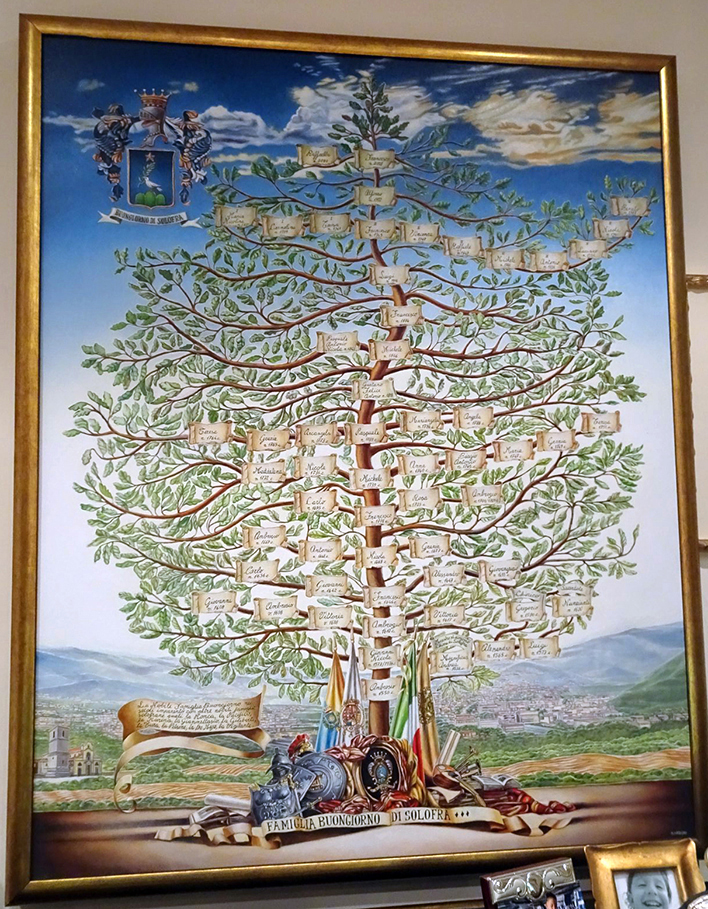
Then he pulled out a rolled up sheet with the family tree of “our” Buongiornos which I had emailed him before the trip (an org chart of boxes generated by a genealogy software program, with not-such-nice artwork). It was poster size. He ordered a digital printout somewhere.
(My work goes back to the 1850s and is based on vital records on microfilm I spent three years of Saturday afternoons reading at a Mormon Family History Center in Brooklyn. You’re welcome, Buongiornos and Troisis.)
Alfonso says, “I have figured out how we are connected. This Michele,” points to a leaf on his tree, “was a brother of this Biagio,” points to my chart, identifying two men who lived in the 1700s.
We are thrilled, and my cousins start snapping photos of all of us, of the “evidence,” etc. (Thank God they were there, because my brain was too overloaded to deal with a camera.)
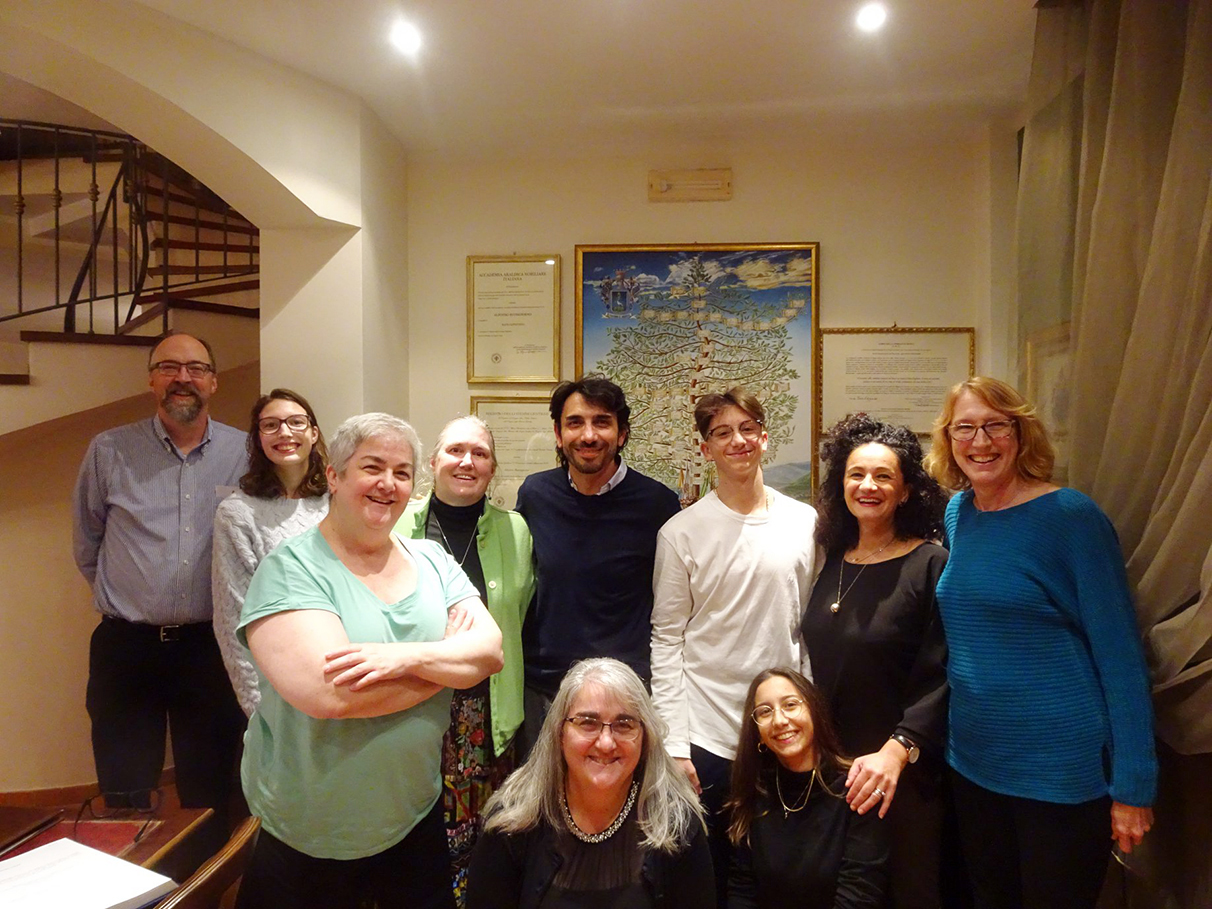
Then Alfonso pulled out the “report” that an Italian genealogist prepared for him of records going back to the 1300s: a 3-inch thick, bound book, on archival-quality paper, with pages that fold out and flip around, xeroxes of some documents, raised-seal (legally legitimate) copies of others.

My cousin Lisa said later, “I kind of blanked out there for a few seconds, because I can’t even conceive that anyone’s ancestry could be known back to the 1300s.”
Alfonso turned to a page he had marked in advance and said, “We are Jews. Conversos from Spain.”
He pointed to a line he had underlined. “The family name Buondiaz (Bonadies in Ladino) was translated to ‘Buongiorno’ in Italy.” (Spanish, Ladino and Italian, they all mean “good day”—which is used for “hello.”)
My family members’ jaws dropped; I smiled with pleasure. I had heard of this possibility before.
Years ago, an Italian art dealer told me that Buongiorno might be a Jewish name, explaining that “conversos”—Jews who converted to Catholicism in Spain during the Inquisition—were also forced to change their Jewish-sounding family names. They often “hid in plain sight” by choosing very common words from the local language for their new last names, such as “hello, goodbye, good day, good year.”
Alfonso explained that the family were tanners in Spain. When they left Spain in the 1300s, they went to the tanning center of Italy: Florence. After being there for a few hundred years, a Solofrano land owner (baron) offered them a deal—land for tanneries, plus favorable terms (probably in exchange for substantial taxes)—to move to this place in the south that had the necessary raw materials (goats, sheep, water) to set up a competing tanning industry.
They have been successful. Florence and Solofra together produce 60% of the leather that is used by the Italian fashion industry today.
Now I understand why Mimma De Maio—the Solofra historian who wrote solofrastorica.it—did her Ph.D. dissertation on the “medieval” tanning industry of Solofra. Because that’s when the industry started in this town; her paper is about the entire history of this defining industry of this southern town.
And now I really have to learn Italian, so I can read that paper, and more of her website.
Alfonso’s family are still tanners. He and his father and brother own a tannery in town.
At some point, “my” Buongiornos, the ones descended from 1700-something Michele’s brother Biagio, left tanning, and by the 1800s, were tailors, barbers, midwives and artists (which I know from my Mormon Family History Center research.) Why and how, I don’t know. As always with genealogy, answers to questions beget other questions.
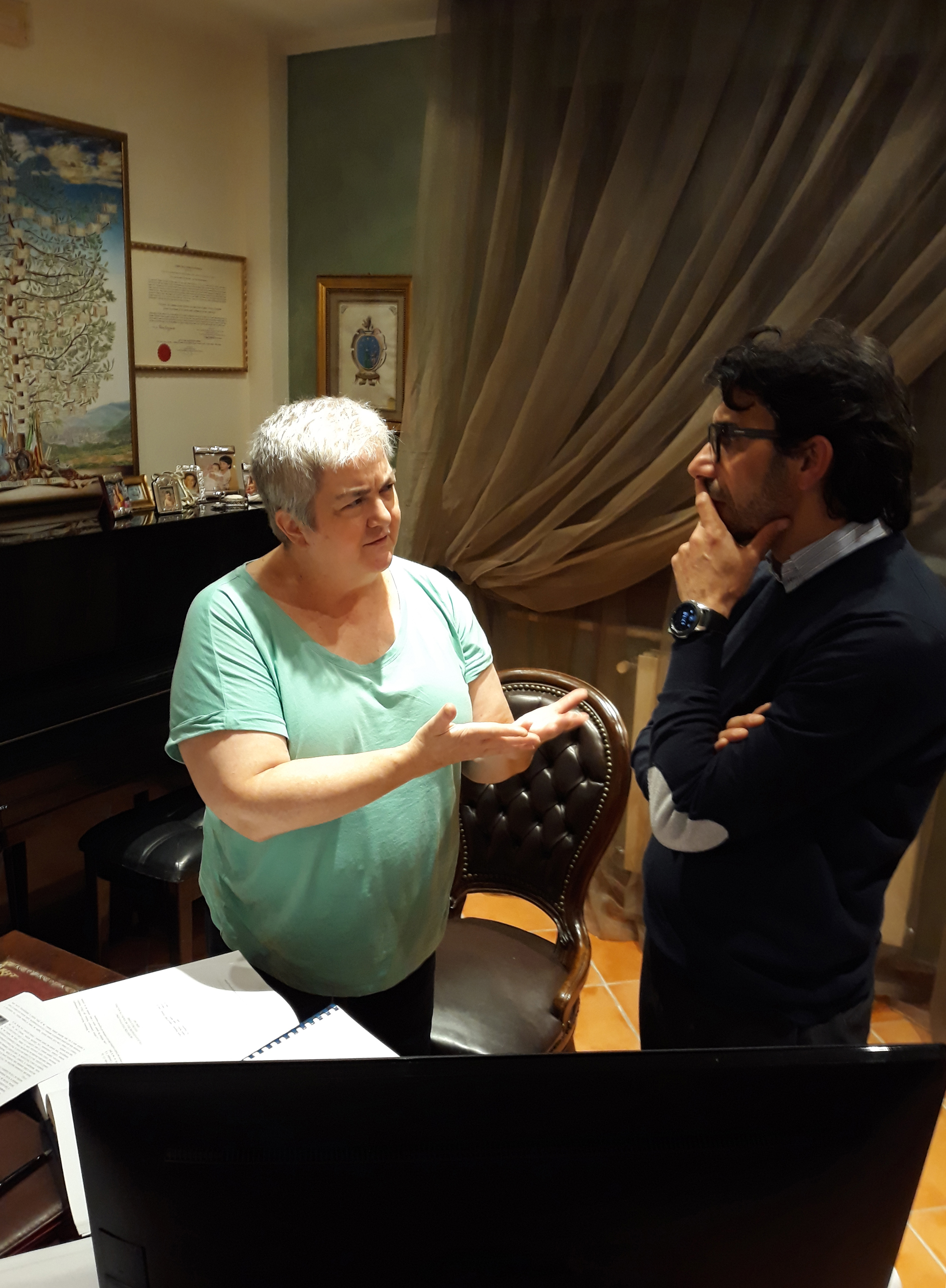
We are hours into our visit. Alfonso and I can go on about genealogy indefinitely, but our family members are ignoring us to eat snacks and talk about other subjects. Both teenagers are still in attendance, engaging with the American relatives they were sure would be bores.


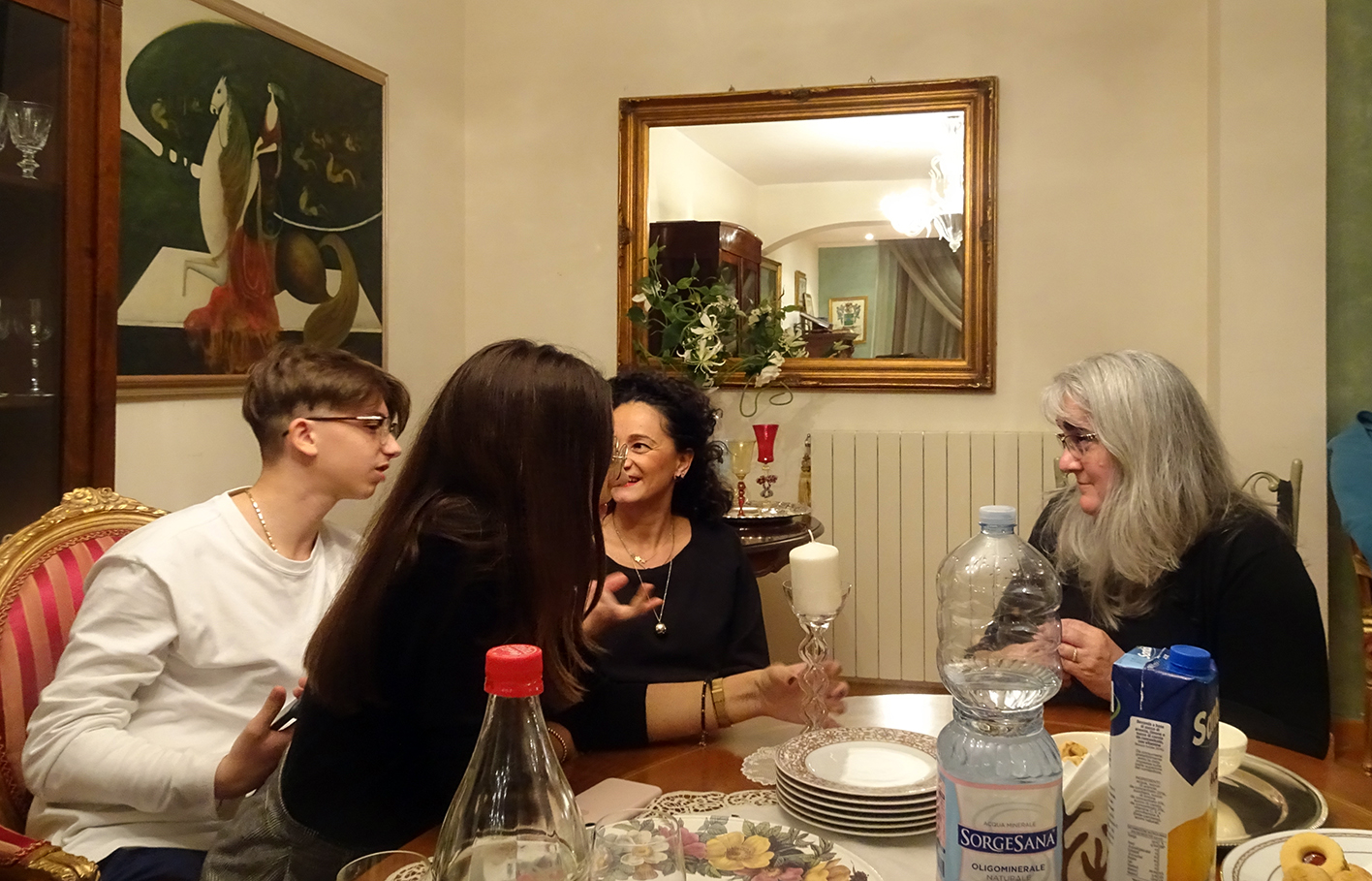
————————
I would like to pay back Alfonso for his hosting and overall wonderfulness by finding him leads for selling his leathers, and this is where you, dear readers, can help.
The tanning industry in Solofra took a serious hit with the 2008 worldwide economic downturn, and Chinese competition is edging in. Alfonso needs a customer who can not afford the time and interruption lost to bad deliveries or not receiving enough usable product to fill an order—someone who will pay a higher price to get reliable product on time. We are looking for a very high end fashion/luxury wholesale customer: a manufacturer who makes gloves, clothing, shoes, wallets, belts, etc.
Do any of my readers know of such a customer? I would not be involved other than to pass a name and phone number to Alfonso’s sales rep in New York. Please use my email or phone to contact me, both are visible all over my websites, and THANK YOU.
————————
Thanks to my sister, Loraine Carapellucci, my brother-in-law, Dave Handley, and my cousins, Julie Holm and Lisa Hamm-Greenawalt, who shot the photos in this post.
]]>Day 14: Thursday, 1 November 2018, morning.
Solofra, Avellino: Ognisanti—All Saint’s Day
We started the day with a breakfast visitor: distant cousin Alfonso Buongiorno. He told us a little history of his family as tanners in the town and asked, “Would we like to visit his home later in the afternoon to see his family tree and talk more?”

“Hell yes, we’ll be there,” I was thinking, but I held back and pretended to wait for my family members to discuss it and come to a group decision. Arrangements were made and he left.
Then we trooped into town to attend the holiday mass in our family’s church. Feminists all, we were favorably impressed that the pastor, Father Mario, made it as progressive as he possibly could within the “rules” of a Catholic mass. Women parishioners helped served communion, and young girls did a reading.
After mass, we followed the crowd to the nearby cemetery, as visiting the dead is what you do on All Soul’s Day. It was down a hill about a mile away.
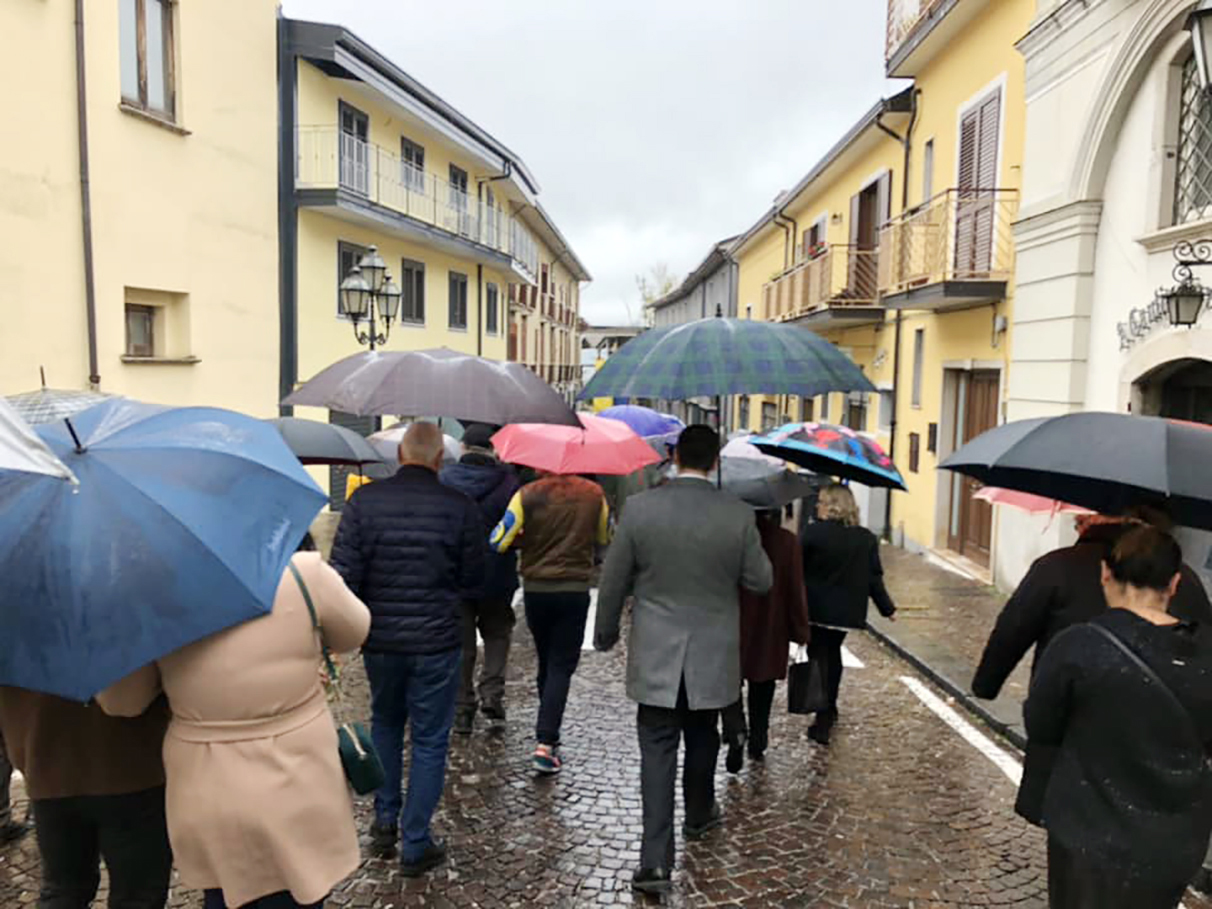
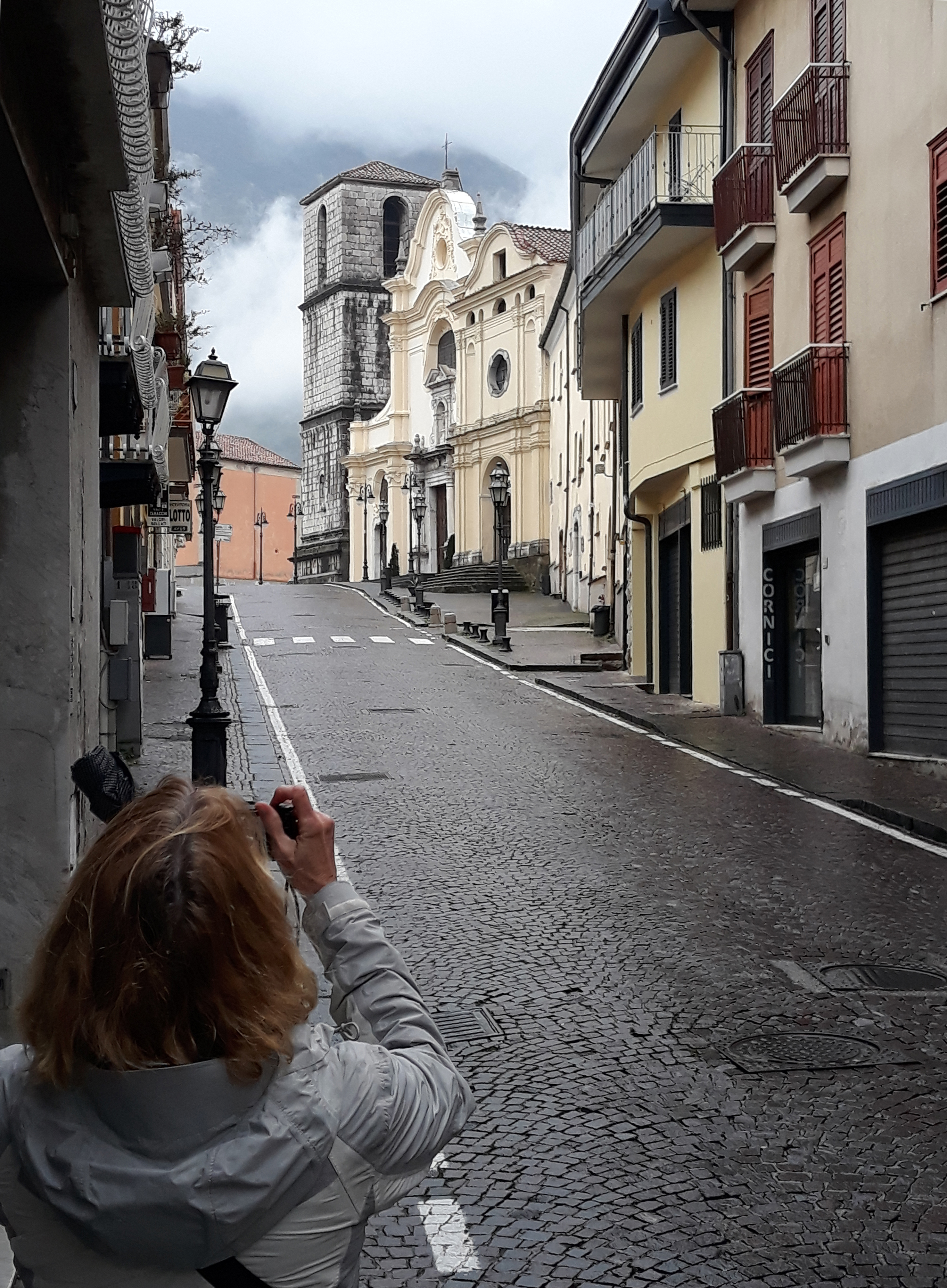
I walked with my sister Loraine for a while. She spied a broken-down chapel and asked if I wanted pictures of it. “Yes, thank you.” I didn’t tell her that it was one of the 5 or 10 “historic” buildings in town I had spied (and marked on a map) while “walking around” via Google Earth 10 years ago—checked that box. (By this point, I was keeping mum about some of my “planning lists,” as my family members were already worrying that I was a bit “around the bend” with my agenda for this trip.)

It was hard to imagine what Solofra looked like when our family lived there in the 1800s, because the 1980 Irpinia earthquake hit this town hard. Some buildings, like this chapel, were left as ruins, while others were rebuilt with new finishes (covered with a thick coat of cement-like material which ruins their historic appearance) or are completely new..
I’m a pokey walker and was lagging behind my family after 10 minutes or so, when…I got a ride! I spied an elderly man I had met the night before (in the church) in a car, waved like a maniac, knocked on the window, and he said, “Sure jump in and get a ride from my son-in-law” (the driver.) I pretended to chat and understand what the three of them were saying in Italian while cruising down the hill to where I met my family members who hadn’t even realized I was missing.
My sister Loraine got pulled out of the route by a local elderly woman who wanted to show Loraine her church, which was along the way. So Loraine went in and dutifully walked around for a few minutes.
Loraine and I found this happened routinely in both of our grandfathers’ small towns which we visited. People were interested in us and proud of their town and wanted to show us things. They also routinely didn’t care that we didn’t understand their non-stop Italian chatter.
The cemetery was interesting. There were lots of tombstones with photos on them and lots of mausoleums with family names on them, including names that we recognized, but we learned that none of them were going to be relevant to us: too new. We were told that graves (in most of Italy and much of Europe, apparently) are re-used after 50 or so years, that the bones that are dug up and put in common ossuaries without specific records of who is in them.
In all the years I’ve spent preparing for this trip, and in the flurry of emails during the last month before I left the U.S., someone couldn’t have told me this crucial detail?
Our ancestors left Solofra in the late 1800s and died in other places—Naples or the U.S. The graves of any family members before them who had been buried in Solofra had been recycled years ago, so we were not going to know anyone in this cemetery.
That kind of killed our interest, but I took a few photos of the more flamboyant tombs anyway, including this Egyptian style monument which can even be seen from the road outside the cemetery (Google Earth photo inserted because I can’t find my own shot), and this grave of a Russo that has a photo (of the dead guy), for my friend Bill Russo of New York, in case they are related, as his family is from Montoro Superiore, a town that is only a mile away from Solofra.
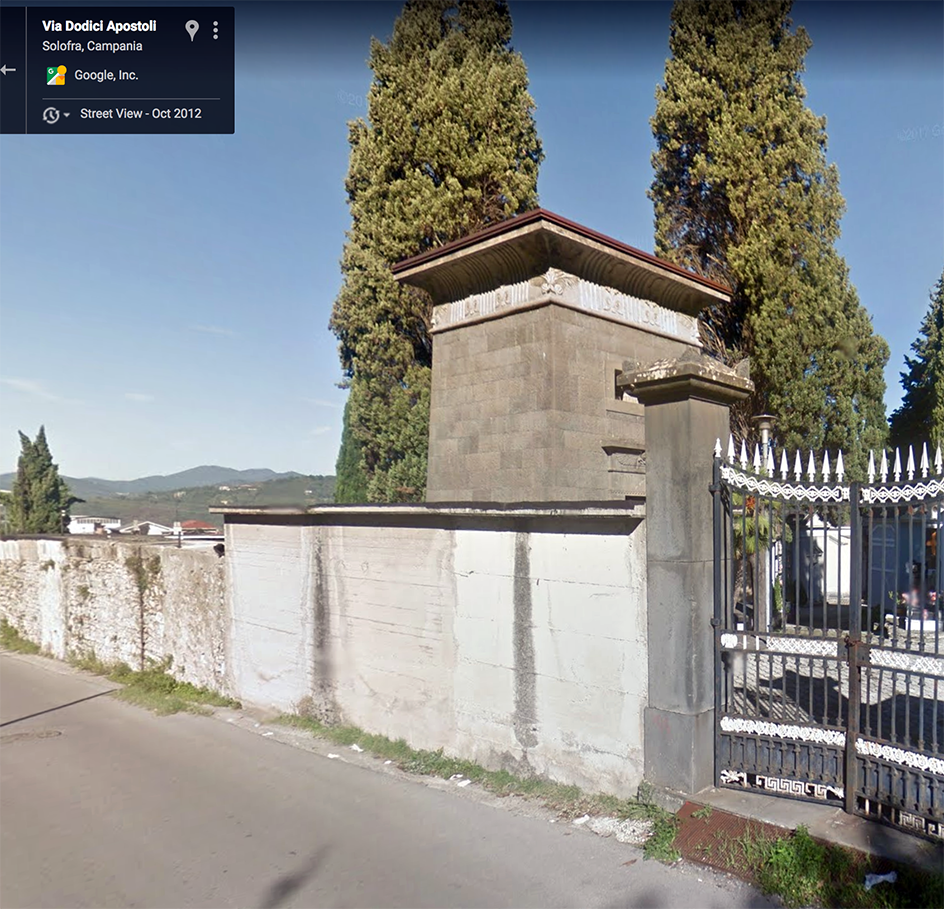
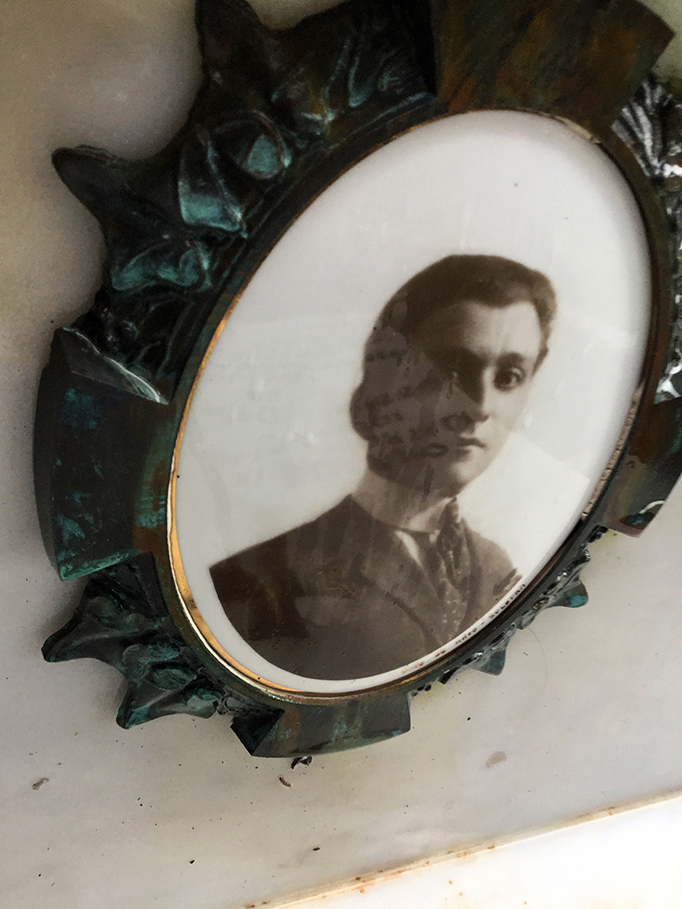

So the cemetery part of the “genealogy experience” of this trip was a bust. But it helped Loraine and I refine our plans for the second, small town we were going to visit. When we went to our other Italian grandfather’s home town the following week (in Abruzzo), we skipped its cemeteries.
We left the Solofra cemetery and went back up the hill for lunch in the main part of town. Then we went back to the Agriturismo to clean up (it had rained all day) for our visit to Alfonso Buongiorno’s house.
Thanks to my sister Loraine Carapellucci, and to cousins Julie Holm and Lisa Hamm-Greenawalt who shot many of the photos in this post.
]]>Day 13: Wednesday, 31 Ottobre 2018.
Travel from Napoli, Campania, to Solofra, Avellino.
Busy day.
We got up early, hustled to the train station, hustled to figure out how to buy the correct train tickets in a vending machine that was in Italian, figured out whose internationally registered credit card to use so it wouldn’t get rejected for being foreign (Julie’s), and hustled to get on the correct train. The one-hour ride to Salerno was pleasant and uneventful. It was a brand new train on brand new tracks.
We hiked through the Salerno station and crossed the street to a rental car place which was reasonably efficient (for Italians) at producing a car in under an hour. Then we wormed our way through local streets to get out of town and headed north on a highway. My sister Loraine was the navigator looking at Google maps or something on her phone and telling her husband Dave, the driver, directions, where to turn, how far to go until the next decision point, etc. It worked splendidly.
In Solofra, we went directly to the Collegiata church, figured out where to park, met our hired guide, Giuseppe Guanci, and got to the city hall by noon for our appointment with Lucia Petrone.
Big breath of relief.
Lucia is lovely and gracious—and speaks machine-gun-fire Italian. Giuseppe can hardly keep up, and when he’s translating to English for us, she interrupts him to tell him even more information in Italian. We hear about the city hall (former palace of Orsini family feudal land owners) and the Collegiata church (La Collegiata di San Michele Arcangelo), all of which I already knew.
It was the afternoon before a 4-day holiday weekend. Lucia had promised us two hours, and I think she was feeling the pressure, as much as we were, to pack those two hours with information.
Me: What about Donatus/Donato Buongiorno? He worked on a restoration of the Collegiata in 1908…?
Don’t know anything about that, but if you want to provide a (mural-size) copy of one of his paintings, we will frame it and hang it in our fancy meeting room here at city hall with the Guarini paintings (reproductions) we already have on display.
Not shabby company for Buongiorno, I think to myself, and make a mental note to follow up on this.
Lucia insists she must show us the church, so we go downstairs, cross the street, and go inside. In one of the big side chapels, Lucia tells us why the painting by Guarini is important: because the figure’s feet are dirty. Because that is proof that Giovan Tommaso Guarini, the Solofra-born artist of many of the paintings in the church (including the stunning scenes on the ceiling), did study with Caravaggio (in Naples)—because Caravaggio famously painted figures in religious paintings with dirty feet. (Caravaggio was an early modernist who re-introduced naturalistic details to reverent scenes.)
Then Lucia took us next door to the former convent and school, part of which is now the town’s public library. A few specific books had been pulled to show us. The librarians, or some other people, were hovering nearby, waiting for us to finish, no doubt, so they could leave early on the holiday evening. Lucia had those people make xeroxes for us. Julie shot photos, Giuseppe continued to try desperately to keep up with Lucia’s talking, and the members of our party surreptitiously took turns slipping out to use the library’s bathroom.
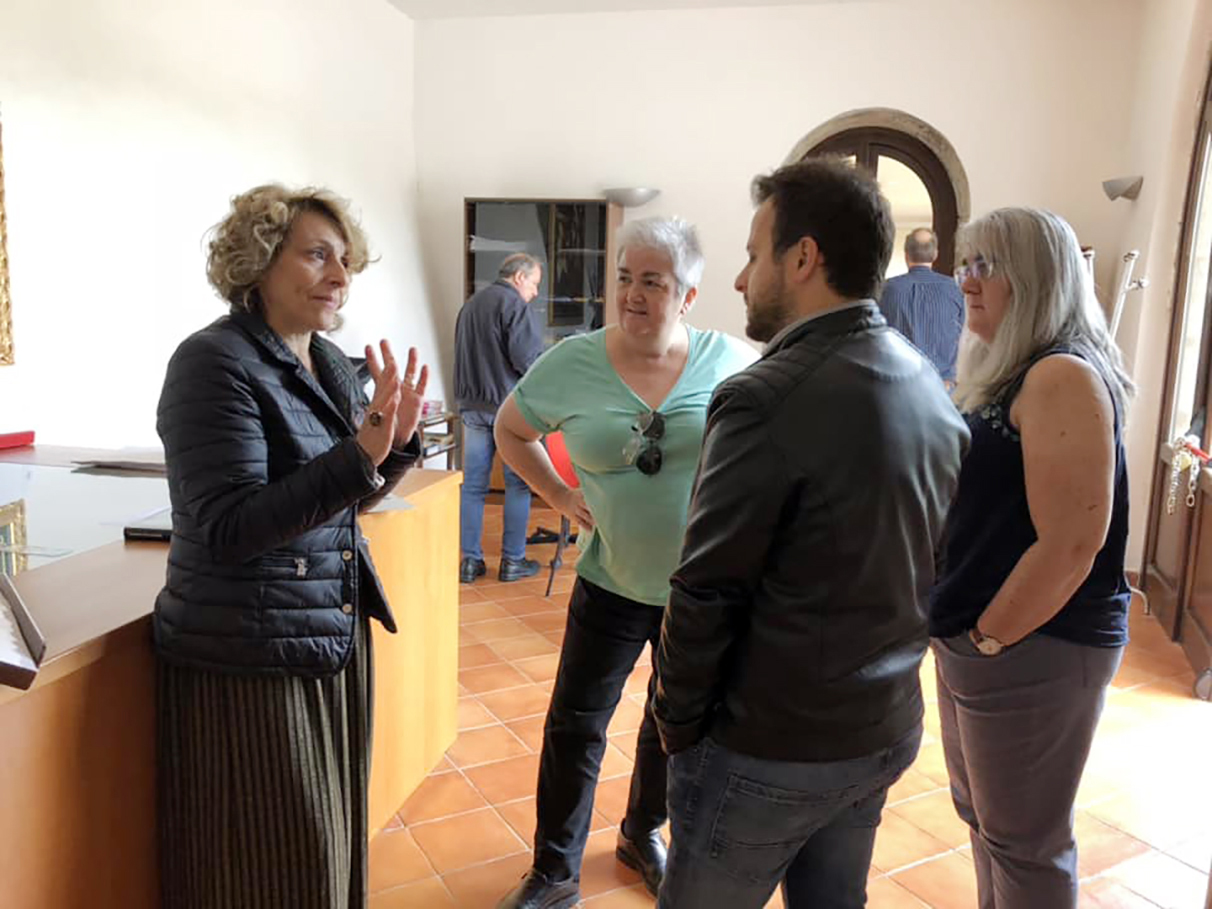
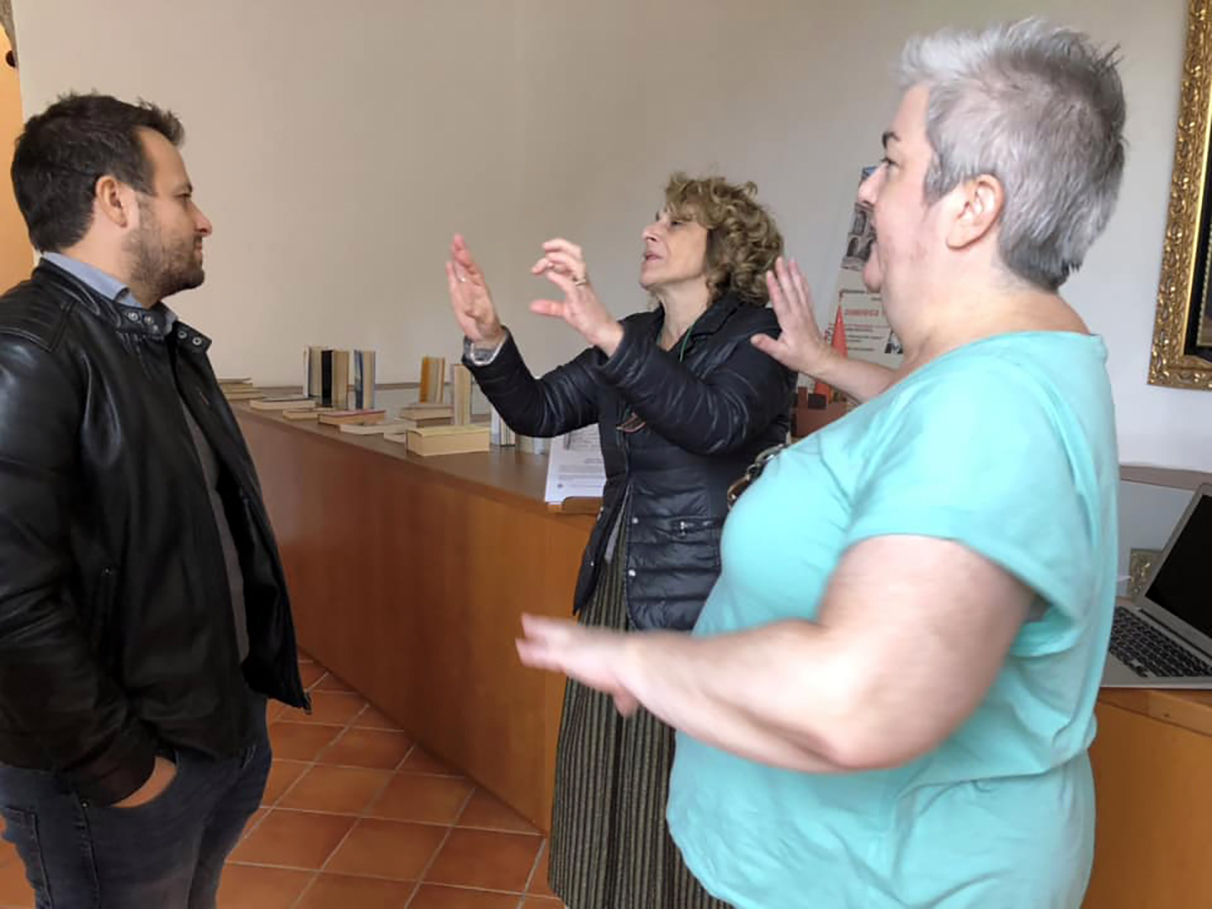
What a head full. I was exhausted trying to keep up with her, and frustrated that she didn’t know anything about the topics I am interested in: Donatus Buongiorno’s career, our family’s tenure in Solofra, etc.
She had to leave at 2 pm. We went back out front. We asked for a recommendation of a restaurant for lunch, and she pointed to La Taverna del Principe across the piazza.
We said goodbye and walked to the restaurant. I invited Giuseppe to join us. What a gold mine. Not only did it give him another two hours to translate for us, but he’s a gourmand who also narrated about the food—of which he approved. He told us that he’s no longer working as a genealogist, actually, but now runs gastronomy tours of the five provinces of Campania—Napoli, Caserta, Avellino, Benevento and Salerno. We let him order for us and choose all the wines.

If you are ready for a gastronomy tour of Italy that your friends who have been to Umbria and Tuscany can only dream about, give this man a call:
Giuseppe G.
Consulente di Viaggi | Aj54
Agenzia di Viaggi /Travel Agency | Aj54, very Authentic Journeys | Via Manfredi, 54 – 83042 Atripalda (Av) | Italy
Tel./Fax. +39 0825 460358 | M. +39 340 3137039
[email protected] | www.aj54.it
After lunch, he walked us to the best dessert place in town—Caffé Vignola—then said goodbye.
The night before, he had sent me some items he photographed at the Avellino library for me. Not until I was back in New York did I look at them and see that they are the 1911 articles about Buongiorno from Le Rane, a vintage local newspaper, which Mimma De Maio, town historian, cites on her site. Yeah!
We sat for coffee and pastries and tried to catch our breath.
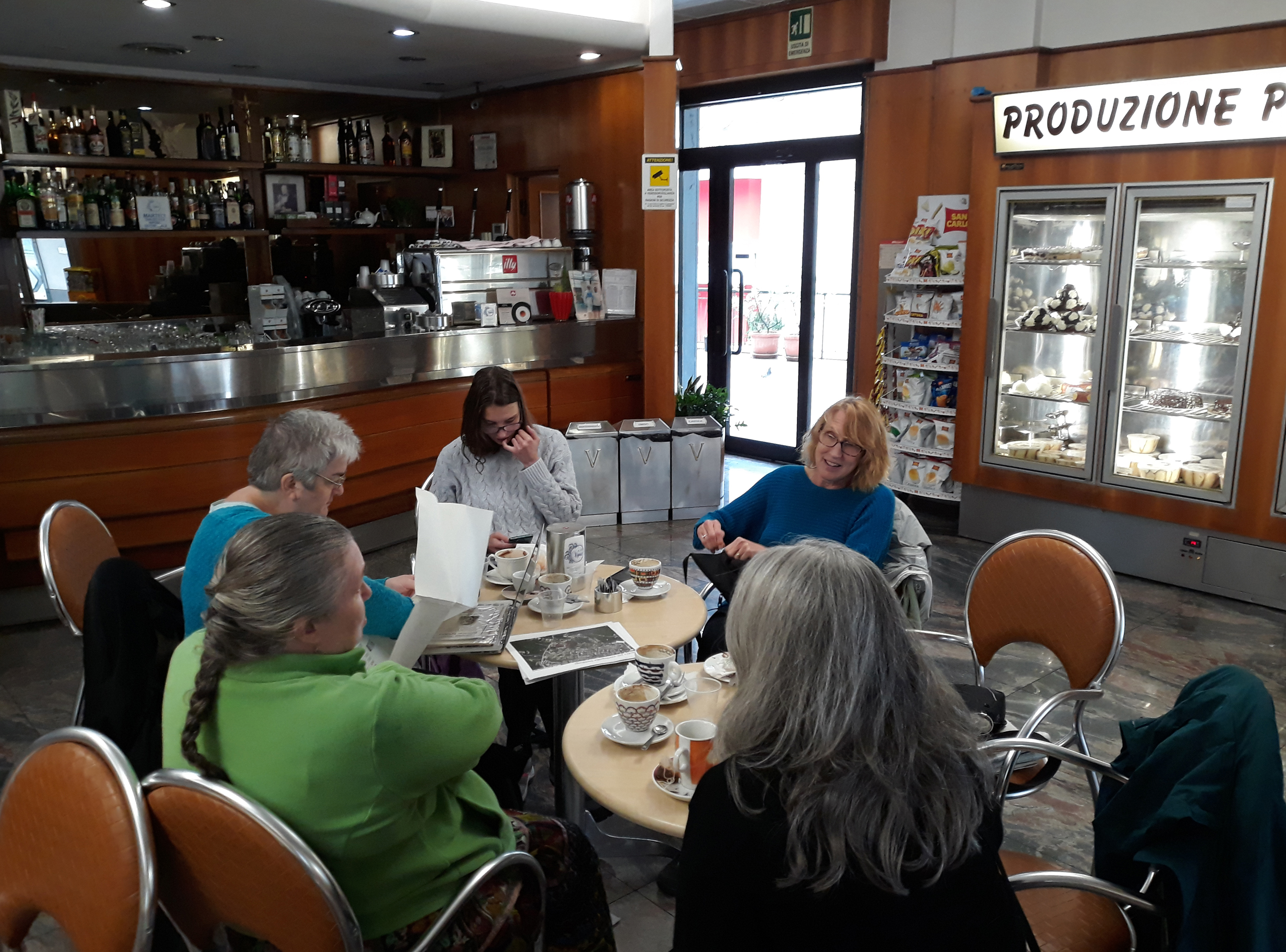
Then we went back to the church to explore at a more leisurely pace. We chatted with “Don Mario” (Monsignor Mario Pierro), the pastor, and met some old men who seem to spend their days hanging around the church. (Curiously, the hang-arounders in New York City Italian Catholic churches are usually elderly women.)
We explained who we were, and, like Lucia, they shrugged at my story of Donatus Buongiorno restoring paintings in the church in 1908, but as soon as they heard “Canonico Troisi,” the flood gates opened. Canon Carmine Troisi, 1866-1948, pastor of the collegiate church for 50 years, was my great-grandfather’s brother. There’s a plaque with the priest’s name on the front of the church, and everyone in town knows who he was.

A few of the men took us into the sacristy to see its paintings (and a glass ossuary holding someone else’s bones including a skull, which was totally gross), and another room where Carmine Troisi’s bones are buried in an ossuary under the floor which has a carved, marble, plaque-like cover. He’s buried with other priests, too, we think—the translating was getting a bit shaky by this point. Then they showed us the farthest-back room, which looked like a school room, which they explained is where Troisi actually died. He had a heart attack or something during catechism class, apparently.
Whew.
So we visited great-grandpa’s brother the priest thoroughly. The priest for whom our great-grandmother, Maria Michela Buongiorno, Donatus Buongiorno’s sister, worked as a housekeeper before marriage, which is how she met great-grandfather Beniamino Troisi. They were married in this church in 1877. Have I adequately explained why we needed to visit this town?
Done with downtown Solofra for the day, we drove up the hill on the north side of town to the Terranova Agriturismo Solofra to check in. Cousins Lisa and Lexie were already there, having come directly from Naples separately from us. Our hosts, Maria Buonanno and her father Norberto Buonanno, are lovely. Later in the evening, Maria cooked us dinner and shot this group photo. (Signor Buonanno is at the table in the back on the left.)
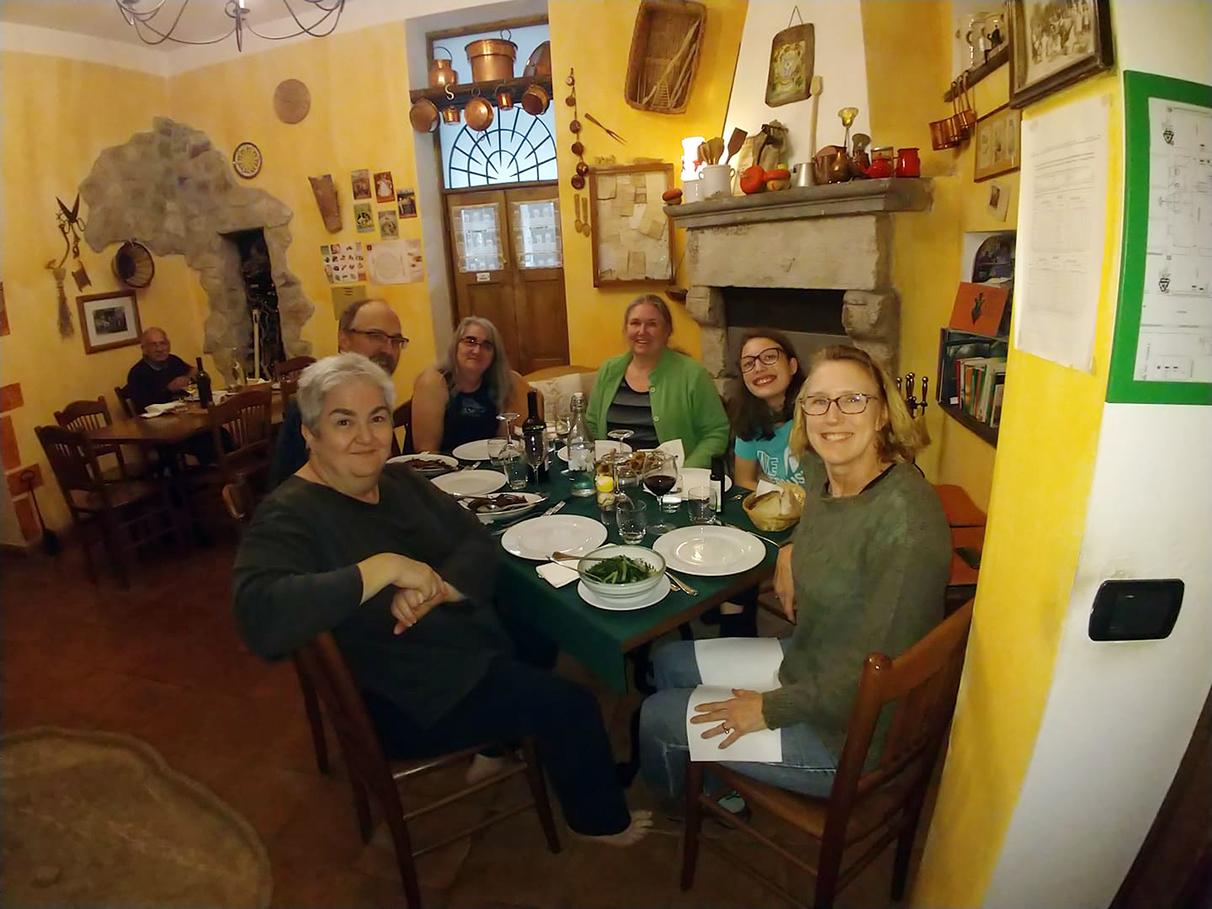
Day 4: Monday, 22 Ottobre 2018.
Napoli, Campania, La Marinella neighborhood.
Train from Rome: Notes for family members who are duplicating this trip in a few days.
There are two train companies that run trains from Rome to Naples. One costs 12 euros and is the “local”. Takes 3 hours, stops at 8 or so towns along the way, including several outlying areas of Naples that we were told are known for drug dealing where dealers and beggars get on the train to transact business and harass passengers. We were told that the trains are old, crappy, not maintained inside, broken seats and you might not get a seat and have to stand the whole way.
We saw the interior of one of these trains as we were leaving the platform in Naples, and it looked no worse than your typical NJTransit or LIRR train to me.
Side note: There is a palpable prejudice against “southerners” in this country. Every single Roman who gave us “advice” about Naples railed on and on about how frightening everything would be. Plus, I am writing this a day later and have spent a whole day walking around the city already. No problems! I think the nasty reports are exaggerated. Yes, we saw a few beggars. No, they were not that aggressive.
The other company is Italotreno.it. Costs 40 euro and is worth it. Takes 1 hr 10 mins, stops once, is a fast, smooth, pleasant ride. I recommend it highly. Brand new tracks, even the gravel they are set in looks clean. For those of us who only know train travel on 100+ year old tracks of the northeast corridor of the U.S., this is a revelation. I watched the train cross two lines at a switch at one point, and you could only barely feel the bump from within the car. I especially encourage Dave H the engineer to choose this option for the “infrastructure experience.”
Plus, we went through, and got glimpses of, this exciting, spectacular, new Napoli Afragola station by architect Zaha Hadid!!!
You can book at their website (assigned seats), but it’s not a smooth interface and took us an hour. Honestly, I think we could have done as well just showing up 20 mins early and buying the seats at the station. We traveled at noon on a weekday and the train was full but not completely sold out. Both stations have segregated spots for buying tix that are less busy than the general station and out of traffic, so you don’t feel nervous handling your cash, credit card, etc.
Speaking of which, no problem using American credit cards to buy stuff so far. Even the tabacchi stands take cards for bus tickets—1,50 in Rome, 1,10 in Naples. (Everything is cheaper in Naples, sometimes by half. Wait ’til you get to Naples to buy routine stuff, if you can.) Last night I used a credit card in a small, family owned restaurant—though I had to go to the “special” cashier to do it which was an amusing adventure.
Both railroad stations — Roma Termini and Napoli Central — are big, busy, typical major city stations and NOT the crime-infested dens of thieves that many report. They are certainly not “relaxing” spaces, never are, but neither did we feel especially besieged or threatened—and we were three typical looking tourists with the screaming clue of dragging wheeled bags. Both stations had visible security, European-style: camo uniforms, machine guns. Architecturally, both are well-designed and interesting. Also completely modern and logically functional (enter building, pass through a “court” containing ticket selling and food, continue straight ahead to tracks and platforms—which are called “binario” in Italian), unlike, say Penn Station in New York which is a compromised horrible mess of urban non-planning. In Rome, you can show your ticket for admission to a segregated waiting area along the heads of the train tracks, which is less busy than the main concourse.
Apartment in Naples: We walked from the station to the apartment in Napoli, which was easy, took 15 mins. I’ll draw a detailed map and send it to everybody, as the nest of streets immediately around the apartment building isn’t the clearest, but also isn’t “bad.”
The apartment is in a batch of buildings that look 1960s era, my guess. From outside, they are ugly. Plain surfaces, not “tidy” looking maintenance, but functional. Also, as in many European cities (especially in hot climates), a/c and sometimes also electrical hearing units are installed on the outsides of buildings, plus all kinds of other crap, such as clothes lines, antennas, meters, etc. (see photo), that make the buildings look like hell, in my opinion (I do care about aesthetics, mind), but they’re not as lower class as my American judgment assumes. Inside: tiles and marble surfaces, neat, clean, no problems.
Our apartment is huge, by city standards. The rooms are bigger than they look at the booking website. Everything is clean and works. I’ve seen worse plumbing and more dysfunctional appliances in many, many places I have stayed (and lived).
There’s not much of a view. The building is surrounded by other hideously ugly buildings, but you can see the weather and get some light. (Unlike, for example, the hotel I just left in Rome, where I had a closet-sized room facing an interior “court”—air shaft—where I couldn’t do either.) My travel guest reports that you can see Vesuvio from our balcony (which adjoins two of the three bedrooms), but I haven’t been out there yet.
You don’t have to “hide” that you’re moving in. We waited in the lobby area of the building for the owner’s rep to arrive to let us in. It was her secretary: Valeria. Vittoria is a lawyer and has an office somewhere nearby. We didn’t meet her. The doorman/guard called Valeria for me (meaning, he knew that the apartment was rented to transients and he knew the lawyer’s office phone number.) Other residents said “Buongiorno” to us while we loitered in their lobby. (If it were NYC, people would quiz you and/or call the cops.) It doesn’t seem to be a secret that there are transients in this unit, nor does anyone seem to care.
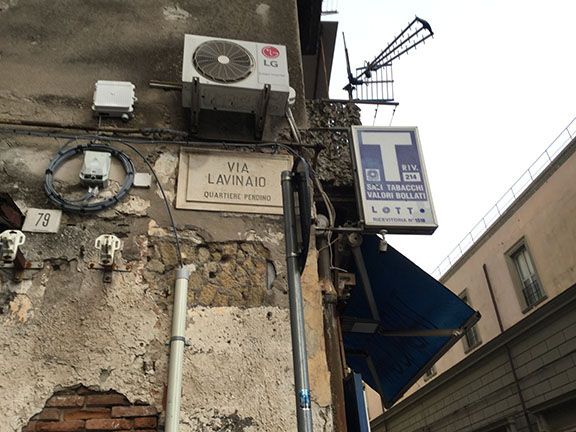
Day 4: Monday, 22 Ottobre 2018.
Napoli, Campania, La Marinella neighborhood.
We are in Napoli, and, ragazzi (guys), the apartment is fabulous! Huge rooms, good location and look at this rainbow, which appeared outside the north-facing balcony of the apartment within minutes of our arrival. I choose to believe my (long dead) grandfather Domenic Troisi delivered this to welcome us to his hometown. The train from Rome was easy, convenient, comfortable and really fast (150 miles/hour we estimated.) I will post directions for the train later to help other family members who are coming from Rome next week.
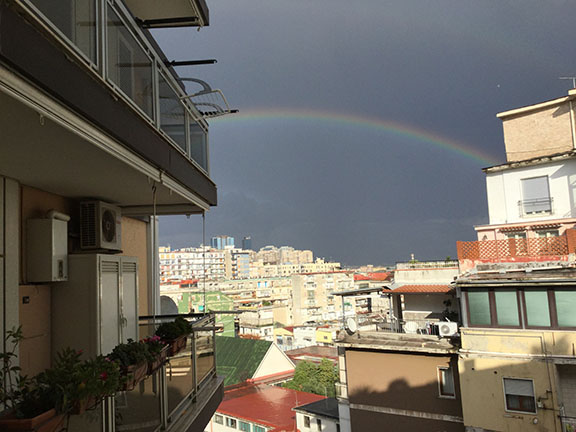
New York, USA, 13 Ottobre 2018.
Our family has a street in Naples!
In advance of our trip, I am communicating with this lovely man, Alfonso Buongiorno, who owns a leather tanning business in Solofra. (https://www.facebook.com/profile.php?id=100015900452619)
He thinks he is related to us like this: Biagio Buongiorno, father of our Great-grandmother Maria Michela Buongiorno Troisi and of artist Donato/Donatus Buongiorno, was a brother of his Great-great-grandfather Michele Buongiorno. (Update Nov 18: Later, when meeting him in person, Alfonso said there were two male cousins with the names of the ancestors we know, which means the ancestor in common is those two mens’ grandfather. This might be a translation issue. I will sort it out based on comprehensive documents Alfonso gave me, and will post definitive information later.)
He will meet us in Solofra on Nov. 1 and show us his family history book with his family tree!
He reports that the Buongiornos have been tanners and goldsmiths (not of jewelry, I learned later: gold leafing of leather and other interior furnishings, such as columns, capitals, walls) in Solofra for centuries, and that some of them went to Naples during each generation to facilitate trade. (Residency was required to get a license for trade, I learned later.)
In Naples, still today, there is a Vicolo Buongiorno, which dates from the time when goldsmith Buongiornos were on the street. (Vicolo, also Vico, means alley.)
Guess what. It’s only a few blocks from Via Cesare Rosaroll where Domenic Troisi and his family lived in 1907 right before they migrated to the U.S.
The plot thickens….
Check it out on Google Earth and see how glamorous Vicolo Buongiorno is today. https://www.google.com/maps/place/Vico+Buongiorno,+80137+Napoli+NA,+Italy/@40.8560405,14.2553281,19z/data=!4m5!3m4!1s0x133b086941cb0da9:0xdec1e3b3eece833c!8m2!3d40.8560405!4d14.2558753
We come from class, people!
